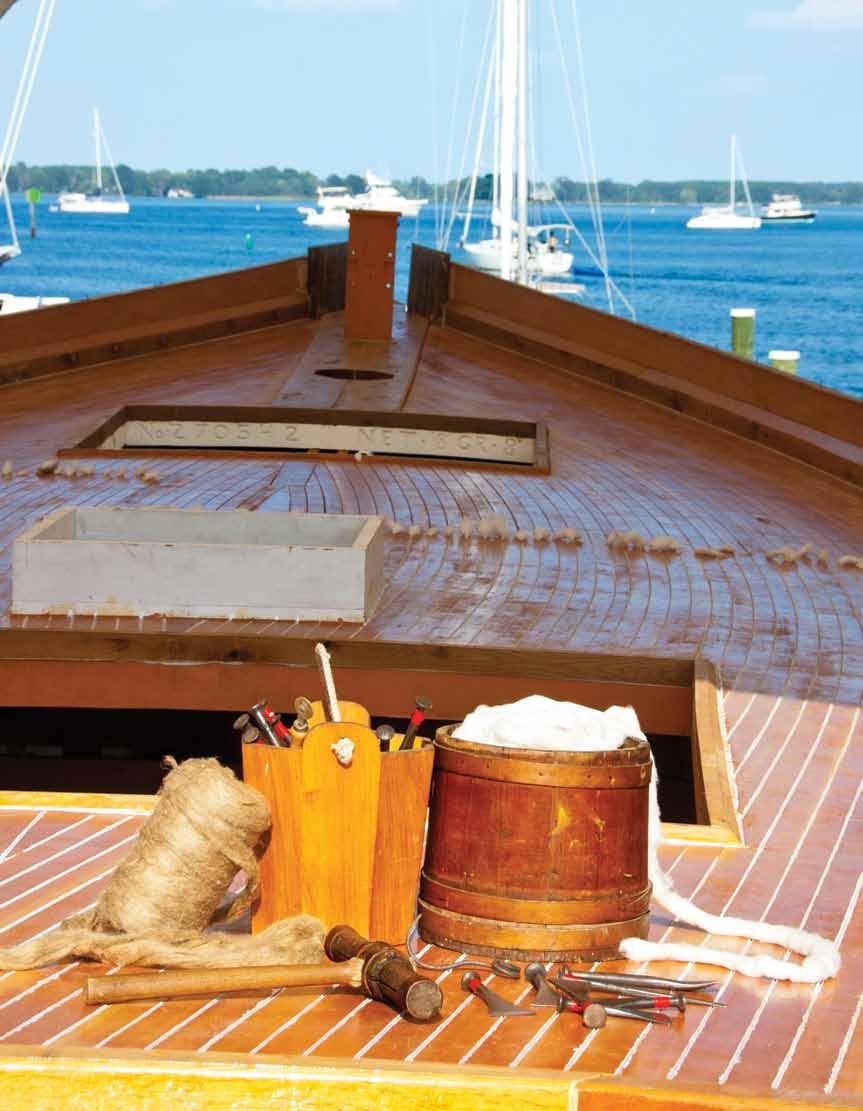
CHAIRMAN’S MESSAGE
by CG Appleby
PRESIDENT’S LETTER
by Langley R. Shook
CURRENTS
Museum welcomes new Board members and Vice Presidents of Development and Constituent Services and bids farewell to summer interns and a long-time staff member. Museum receives grant for War of 1812 exhibit, and event highlights.
CURATOR’S CORNER
Pocahontas
Volunteers recognized for service
Mission Statement
The mission of the Chesapeake Bay Maritime Museum is to inspire an understanding of and appreciation for the rich maritime heritage of the Chesapeake Bay and its tidal reaches, together with the artifacts, cultures and connections between this place and its people.
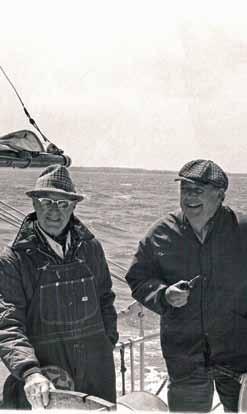
Vision Statement

The vision of the Chesapeake Bay Maritime Museum is to be the premier maritime museum for studying, exhibiting, preserving and celebrating the important history and culture of the largest estuary in the United States, the Chesapeake Bay.
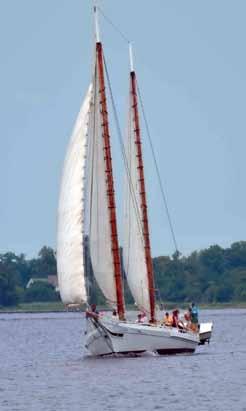
Sign up for our e-Newsletter and stay up-to-date on all of the news and events at the Museum. Email havefun@cbmm.org to be added to our mailing list.
20 23
CALENDAR
(Pictured front row, from left) George MacMillan, Don Goodliffe, Pam White, Connie Robinson, Mary Sue Traynelis, Carol Michelson, Audrey Brown, Molly Anderson, Pat Scott, Paul Ray, Paul Carroll, Mike Corliss, Ron Lesher, Cliff Stretmater, Jane Hopkinson, Sal Simoncini, Elizabeth Simoncini, Annabel Lesher, Irene Cancio, Jim Blakely, Edna Blakely.

(Second row, from left) David Robinson, Ann Sweeney, Barbara Reisert, Roger Galvin, John Stumpf, Bob Petizon, Angus MacInnes, Nick Green, Bill Price, Ed Thieler, Hugh Whitaker, Jerry Friedman.
(Third row, from left) Mike Sweeney, Kirby Scott, Richard Shaw, Karen Shook, President Langley Shook, Rick Kuba, Andy Flanagan, Duane Lundahl, Joe Irr, Lloyd Devigne, and Bob Hinkel.
At a June 14 reception held on Fogg’s Landing in St. Michaels, the Museum recognized members of its dedicated corps of more than 200 volunteers for their combined 28,220 hours of service to the Museum over the course of the last year—the equivalent of nearly 15 full time employees. Several staff members recognized individual volunteers for their work in the education, buildings and grounds, curatorial, Museum Store, boatyard, boat donations, and administra tive departments. Volunteers with more than 100 hours of overall service were also recognized and presented pins for their service.
Special recognition was given to volunteers with the highest hours of service, including Rosemary Thomson with 10,000 hours; Bob Mason with 6,000 hours; Joan Chlan with 5,000 hours; Bill Price with 4,000 hours; John Hawkinson, Paul Ray, and Bob Whitlock with 3,000 hours; Paul Carroll, Jerry Friedman, Roger Galvin, Bob Petizon, and Mary Sue Traynelis with 2,000 hours; Nick Green and Angus MacInnes with 1,500 hours; and Sam Barnett, Audrey Brown, Russ Cochran, Gloria Freihage, Gerry Hughes, Rick Kuba, Mike Corliss, Cliff Stretmater, Ed Thieler, Ben Tilghman, and Bob Traynelis with 1,000 hours each.
Keep up-to-date on Facebook. facebook.com/mymaritimemuseum
Follow the Museum’s progress on historic Chesapeake boat restoration projects and updates on the Apprentice For a Day Program. Chesapeakeboats.blogspot.com
A general education forum and valuable resource of stories, links, and information for the curious of minds. Beautifulswimmers.tumblr.com
Watch our Rosie Parks skipjack restoration updates and more at youtube.com/CBMMorg1965

The Chesapeake Bay Maritime Museum
Navy Point, PO Box 636 St. Michaels, MD 21663 410-745-2916 • cbmm.org
On the cover:
Traditional caulking tools lie on the deck of the skipjack Rosie Parks. Photo by Tracey Munson.
Editors: Tracey Munson & Marie Thomas
Creative Director: Marie Thomas
Copy Editors: Mariana Lesher & Emilie Knud-Hansen
Contributing Writers: Dick Cooper, Kate Livie, Langley Shook, CG Appleby, Esty Collet, Tracey Munson, Marie Thomas, Elisabeth Meier, Richard Scofield, and Michelle Zacks.
The Chesapeake Log is a publication of the Chesapeake Bay Maritime Museum.
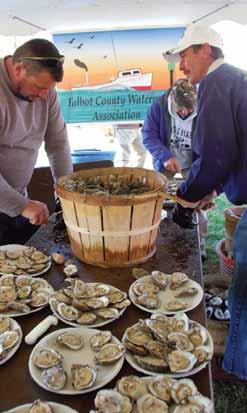
contents
2012 1 FALL 2012 THE CHESAPEAKE LOG THE CHESAPEAKE LOG FALL 2012 2
Fall
3 4 5 11 12 13 14
Nameboard Restored by Elisabeth Meier
LIFELINES
RESEARCH Tide, Trade, and Tugs: The Ward Family of Deltaville
EDUCATION What’s Fresh? Seasonal Selections from Education by Kate Livie Exploring Public Perceptions of Science with ALL by Esty Collet 15 20 21 25 FEATURES Gentlemen... The Situation has Changed by Dick Cooper History on the Half Shell by Kate Livie ON THE RAIL Edna sails again, plus updates on the Rosie Parks project.
Profile: John Ford by Tracey Munson
by Michelle Zacks
St. Michaels Concours d’Elegance, Mid-Atlantic Small Craft Festival, Maritime Monster Mash, Oyster Fest, woodworking workshops, exhibit spotlights, and more.
HEROES HONOR ROLL
15
PHOTO BY DICK COOPER
Chairman’s Message
byCGAppleby,ChairmanoftheBoard
As the summer heat fades and gives way to cooler autumn breezes filled with noisy geese, the Museum has much to look forward to this fall.
On September 30, our campus will be filled with a stunning array of vintage automobiles from the Golden Age of Motoring, circa 1900-1942, as well as a display of classic wooden speedboats from the same era.
Just a few days later on October 6 and 7, three decades of small boats, family, and community culminate in the 30th Annual Mid-Atlantic Small Craft Festival. What began as a casual gathering of boaters with an interest in small rowing and sailing craft has since evolved into one of the nation’s premier small craft events. OysterFest is returning on November 3 with plenty of oysters, boat rides, live music, and lots of family activities—it’s a day spent enjoying what makes the Chesapeake region so special.
The Museum also sees the return of hundreds of students from all over the Mid-Atlantic region in the fall, some learning about the Chesapeake Bay for the first time. You’ll find them racing up the steps of the Hooper Strait Lighthouse, crawling through the E.C. Collier in the Oystering Exhibit, and collectively squealing with delight at the sight of a sea squirt wriggling in their hands as they cruise the Miles River aboard Mister Jim during an ecology cruise.
With member events, educational programming, new exhibits, special events, and more, the Museum offers many reasons to renew your membership year after year, and to encourage others to join. This past summer is a shining example of how members are embracing our Museum—record attendance at the Antique & Classic Boat Festival, Chesapeake Folk Festival, and Watermen’s Appreciation Day, as well as sold-out educational programs and member events.
Besides the many perks of belonging—free general admission, free or reduced admission to special events, members discounts, docking privileges, The Chesapeake Log, and more—your membership plays a vital role in supporting not only the Museum, but our mission to inspire an understanding of and appreciation for the rich and varied maritime heritage of the Chesapeake Bay and its people. Please come visit your Museum this fall and enjoy what you, as a member, have helped to create and sustain.
Board of Governors 2012-2013
CG Appleby, Chair
Tom D. Seip, Vice Chair
James P. Harris, Treasurer
Richard C. Tilghman, Secretary
Schuyler Benson
Paul Berry
Richard J. Bodorff
Harry W. Burton
William S. Dudley
David E. Dunn
Anna W. Fichtner
Dagmar D. P. Gipe
E. Brooke Harwood, Jr.
Christopher A. Havener
Francis Hopkinson, Jr.
Fred Israel
Pamela Jana
Richard H. Kimberly
Peter M. Kreindler
Frank C. Marshall
Geoffrey F. Oxnam
Bruce A. Ragsdale
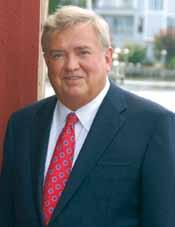
Mitchell Reiss
Diane J. Staley
Henry H. Stansbury
Benjamin C. Tilghman, Jr.
Alfred Tyler, 2nd
Emeriti
Richard T. Allen
Margaret D. Keller
Breene M. Kerr
Charles L. Lea, Jr.
D. Ted Lewers, MD
Fred C. Meendsen
John C. North II
Sumner Parker
Robert A. Perkins
James K. Peterson
Norman H. Plummer
John J. Roberts
Henry H. Spire
James E. Thomas
Joan Darby West
Donald G. Whitcomb
Museum Staff
President
Langley R. Shook, President, 4951
Cheryl Miller, Administrative Assistant 4943
Breene M. Kerr Center for Chesapeake Studies
Pete Lesher, Chief Curator, 4971
Richard Scofield, Assistant Curator of Watercraft, 4966 Rob Forloney Director of the Kerr Center, 4959
Kate Livie Director of Education, 4947
Eric Applegarth, Exhibits Specialist, 4945
Lynne Phillips, Collections Manager, 4972
Helen Van Fleet Education & Reservations Assistant, 4941
Michelle Zacks, Museum Folklorist, 4961
Boatyard
Marc Barto, Rosie Parks Project Manager, 4967
Mike Gorman Vessel Maintenance Manager, 4967

India Gilham-Westerman, Shipwright Apprentice
Jennifer Kuhn, Journeyman Apprentice
Ken Philips, Shipwright Apprentice
Communications & Special Events
Tracey Munson, Vice President of Communications, 4960
Marie Thomas Communications Manager, 4953
Melissa Spielman, Director of Events & Volunteer Program, 4956
Ida Heelan Events Coordinator, 4944

Development
David Crosson, Vice President of Development, 4984 Constituent Services
René Stevenson Vice President of Constituent Services, 4950
Debbie Collison Membership Manager, 4991
Emilie Knud-Hansen Mem/Develop. Assistant, 4955
Jody Andrews, Dockmaster, 4955
Megan Fisher, Museum Host, 4945
Anne Robling, Museum Host, 4945
Finance
Jean Brooks, Vice President of Finance, 4958
Craig Atwood, Director of Finance, 4958
Brenda Faulkner Staff Accountant, 4948
Digie McGuirk Accounting/HR Assistant, 4957
Patti Meschino Administrative Services Specialist, 4963
Marty Smythe Museum Store Manager, 4963
Devon Duvall Sales Associate, 4962
Operations
Bill Gilmore Vice President of Operations, 4949
John Ford, Facilities Manager, 4970
Lad Mills, Boat Donations Program Manager, 4942
Andrew Walter, Boat Donations Program Assistant Manager, 4942
Sam Fairbank, Facilities Maintenance Assistant, 4969
Joseph Redman Facilities Maintenance Assistant, 4969
To contact, dial 410-745, and the number listed.
To email, use the first initial, full last name @cbmm.org.
President’s Letter
byLangleyR.Shook,President
Let me begin by again thanking our more than 200 volunteers who last year donated a combined total of over 28,000 hours of service to the Museum—the equivalent of almost 15 full-time employees! We simply could not operate without their tireless and dedicated efforts, and we’re enormously grateful for everything they do.
I’m also delighted to announce two new staff appointments—the Museum’s new Vice President of Development, David Crosson, and the promotion of René Stevenson who becomes Vice President of Constituent Services while continuing her strong leadership of our Annual Fund and membership programs. (Read more on page 7.) As discussed below, development and fundraising are as important now as they ever have been in the Museum’s 47-year history. Your steadfast support has enabled the Museum to buck the trend in the recent down economy that has seen most of our peers face declining memberships, declining attendance, and declining charitable dona tions. The Annual Fund has set all-time records in each of the past three years, while our membership levels and attendance also have risen. Yet membership dues and admissions receipts, combined, currently provide less than a third of the revenue necessary to support the Museum’s important mission.
We soon will begin our Annual Fund appeal, with a goal this year of raising over $600,000 to sustain and expand our programs and exhibits that make the Museum perhaps the most prominent cultural and historical institution on the Eastern Shore. Almost 1,500 of you contributed to the Annual Fund last year and we’re counting on others to join in to keep participation levels rising. While the Annual Fund historically has provided more financial support to the Museum than membership dues, we cannot stress enough how important it is that members like you continue to renew membership year after year, often at higher levels, or as lifetime members. We cherish your faithful support and thank you for it. To build a stronger Museum, we need more members like you.
If you’ve brought an out-of-town guest to the Museum time and again, and they love it, then why not ask them to join? Consider asking your neighbor who loves the Bay so much, to join your Museum. Another generous way you can share your love of the Bay, Navy Point, the old boats and the stories we hold, is to give a membership to a family member or friend.
There’s a convenient envelope stapled inside, and I invite you to pull it out right now and renew and extend your membership—perhaps at the next higher level—or order a new membership for someone who would enjoy and appreciate your Museum as much as you do. It will make you feel good—and your Museum and its important mission will love you for it!
3 FALL 2012 THE CHESAPEAKE LOG THE CHESAPEAKE LOG FALL 2012 4
Museum welcomes new board members
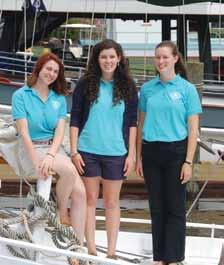
Pictured inside the Museum’s newest exhibit, Push and Pull: Life on Chesapeake Bay Tugboats are front row, from left: Norman Plummer (Emeritus), Howard Freedlander (retired), Judge John C. North II (Emeritus), Bruce Ragsdale, Fred Meendsen (Emeritus), Fred Israel, Diane Staley, Pam Jana, Dagmar Gipe, Richard Bodorff, and Jocelyn Eysymontt (retired); second row, from left: David Dunn, Chris Havener, Alan Griffith (retired), Langley Shook (President), Harry Burton, Fred Cross (retired), Frank Marshall, Jim Harris (Treasurer), Mark Nestlehutt (retired), Alfred Tyler, Ben Tilghman, and Frank Hopkinson; third row, from left: Anna Fichtner and Henry Stansbury; fourth row, from left: Joe Peters (retired), Sumner Parker (Emeritus), and Bob Perkins (Emeritus); fifth row, from left: Paul Berry and Geoff Oxnam; sixth row, from left: CG Appleby (Chair), Richard Kimberly, and Bill Dudley.

Not pictured: Schuyler Benson, Brooke Harwood, Doug Jurrius (retired), Peter Kreindler, Bill Millar (retired), Mitchell Reiss, Tom Seip (Vice Chair), Richard Tilghman (Secretary), Barbara Viniar (retired). Emeritus Governors not pictured: Richard Allen, Margaret Keller, Breene Kerr, Charles Lea, Ted Lewers, Jim Peterson, John Roberts, Hank Spire, James Thomas, Joan Darby West, and Donald Whitcomb.
On June 18, the Museum elected four officers and five new members to its Board of Governors. Newly elected to three-year terms on the Museum’s Board of Governors are Schuyler Benson, Fred Israel, Frank Marshall, Mitchell Reiss, and Diane Staley. Newly elected as board officers are Vice Chair Tom Seip, Treasurer James Harris, and Secretary Richard Tilghman, Jr. Museum Chair CG Appleby was reelected to a second term.
The Board also recognized retiring governors Fred Cross, Jocelyn Eysymontt, Howard Freedlander, Alan Griffith, Doug Jurrius, Bill Millar, Mark
Nestlehutt, Joe Peters, and Barbara Viniar for their service. At the meeting, retiring board members were presented a memento made from the original wood of the skipjack Rosie Parks, now under major restoration at the Museum through 2013.
“The Museum is privileged to count among its governors some of the most accomplished and generous people in the region,” commented Museum Chair CG Appleby.
“We are pleased to benefit from the service of all our board members— retiring, continuing and new, and feel fortunate to have their talents and
resources as key components in furthering the Museum’s mission.”
New board member Schuyler Benson was born and raised in Easton, MD, and is currently employed with Benson & Mangold Real Estate. Benson earned a Bachelor’s degree from HampdenSydney College in Farmville, VA, before returning to the Eastern Shore to pursue his career in real estate. As a past president of the Mid-Shore Board of Realtors, Benson is active in the real estate community, having also served on the Maryland Association of Realtors. He currently serves on the boards of The United Fund of Talbot
County and the Waterfowl Festival. Benson, his wife Jenny, and their two children live in Easton.
Fred Israel of Royal Oak, MD, earned his BSEE Engineering degree from New York City College. In 1957, he founded Fred Israel Associates, a consulting engineering liaison and technical marketing company. Israel later received his Juris Doctor degree from Georgetown University in 1963, opening the law offices of Fred Israel the same year, which later became Israel & Raley. Israel also co-founded Trident Labs in 1963 and Syscon Corp. in 1966. In addition to serving on numerous boards, Israel has served as a Georgetown University Board of Regents member and the Academic Committee Chairman for Wheeling Jesuit University. He currently serves as president and board member of Temple B’Nai Israel in Easton. He and his wife Lesley have homes in Royal Oak, MD and Washington, D.C.
Frank Marshall, of Royal Oak, MD, joined the Lockheed Missiles and Space Company in 1980 as company counsel after seven years on U.S. Army active duty in the Judge Advocate General Corps. In 1987, he moved to Litton Industries and in 1994 was elected Corporate Vice President and Deputy General Counsel. After Litton’s 2001 merger with Northrop Grumman, Marshall was appointed Vice President, Associate General Counsel, and Sector Counsel.
After retiring from Northrop Grumman in 2009, Marshall was appointed to the Lockheed Federal Credit Union Board of Directors and currently serves on the Management Development and Compensation Committee, Finance Committee, and the Operations Committee. Marshall holds a Bachelor of Science degree from Georgetown University’s School
of Foreign Service and a Juris Doctor degree from Hastings College of the Law, University of California.
Mitchell Reiss, of Chestertown, MD, is the 27th president of Washington College. Reiss is a leading expert on American foreign policy and is internationally recognized for his negotiating skills during the Northern Ireland peace process and the North Korean nuclear crisis. During the past decade, Reiss held a number of leadership positions at the College of William & Mary in Williamsburg, VA, and held appointments in the School of Law and the Government Department.
He currently serves on a number of boards and advises private sector companies and philanthropic organi zations. Reiss has a law degree from Columbia University Law School, a Doctor of Philosophy from Oxford University, a Master’s degree from the Fletcher School of Law & Diplomacy, and a Bachelor’s degree from Williams College. He is the author of various books, articles, and reviews.
Diane Staley, of Bozman, MD, has 25 years of marketing, advertising, strategic communications, public relations, sales and event experience in corporate and advertising agency executive positions. In 2002, Staley retired from her position as Senior Vice President of Interactive Marketing for AOL/Time Warner. Staley developed and implemented interactive marketing and advertising programs for national brands including General Mills, Citigroup, Target, Ford, Microsoft, and Warner Brothers. Staley received her Master’s degree in Public Relations/ Mass Communications from Boston University and her Bachelor of Arts, Journalism degree from Purdue University. She and her husband, Jeff, live in Bozman.
In August, the Museum bid farewell and good luck to long-time boatyard staff member Don MacLeod. He began his apprenticeship during the two-week clean-up from hurricane Isabel in September 2003, and stayed three years before being promoted to Floating Fleet Assistant. MacLeod was recently accepted into the Marine Systems Program at The Landing School in Arundel, Maine, where he will be trained in diesel engines, electrical, refrigeration, and plumbing. We also thank our summer interns Brittni Landgraff, Julia Flood, and Elisabeth Meier (pictured above) for all of their hard work and wish them well on future endeavors.

currents 5 FALL 2012 THE CHESAPEAKE LOG THE CHESAPEAKE LOG FALL 2012 6
New Vice Presidents of Development and Constituent Services announced
David Crosson has joined the Museum as Vice President of Development. Crosson brings a wide range of relevant experience to his new position, as a previous marketing and communications campaign strate gist who has worked extensively with non-profit advocacy organizations, providing many with fundraising and grant application support. In addition, he has worked in public relations as Senior Vice President for Corporate and International Public Affairs in the Washington office of Edelman Public Relations Worldwide.
Crosson has managed high profile, issue-advancement campaigns, serv ing under General Colin Powell as communications director for the Presidents' Summit for America's Future—a joint initiative of Presidents Clinton and Bush to generate greater corporate funding and volunteer service for young people in need.
In announcing Crosson's appoint ment, President Langley Shook said, “We're pleased to welcome Dave. He was selected from a field of more than 80 candidates after a thorough search process that included interviews by more than a dozen senior staff and Governors. His appointment comes at a critical time.

The Museum is blessed to have over 5,000 members and tens of thousands of visitors each year, yet membership dues and admission receipts combined provide less than a third of our finan cial support. We need to build our donor base, and Dave's got the skills, experience, and passion for our cause
to lead these development efforts.”
Crosson’s connections with the sea began early, having worked as deckhand and mate on all manner of craft, including historic coastal schooners, tugs, dredges, and offshore fishing draggers. He's the owner of a classic wooden sloop that he sailed on the Chesapeake for many years as a member of the Museum. Crosson began his professional career as a journalist reporting, writing, and editing on energy, the environment, healthcare, international trade, and maritime issues for a variety of publi cations, including Hearst Newspapers, Newsweek, and several McGraw-Hill newsletters and magazines.
In response to his appointment, Crosson said, “I'm lucky. The Museum is much more than a repository of artifacts from a disappearing maritime culture. It's a celebration of values that are as vital today as ever. My aim is to build funding not just to sustain the Museum, but to grow it as well.”
Crosson is a graduate of Amherst College, BA, English, cum laude. He is the father of two—Dylan, 16, and Margaret, 15.
René Stevenson has been appointed Vice President of Constituent Services. In her new position, Stevenson continues overseeing membership, the Annual Fund, and staffing the Board of Governors, while adding responsibility for the Visitor’s Center, marina, and the Talbot Street Welcome Center. Stevenson joined the Museum three years ago after a 20-year career in bank ing administration and nine years in business development at the A.I. duPont Hospital for Children in Delaware.
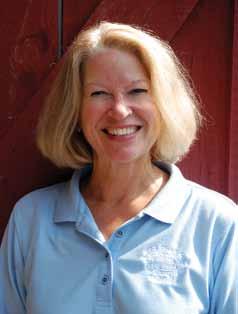
Museum receives grant for War of 1812 exhibit
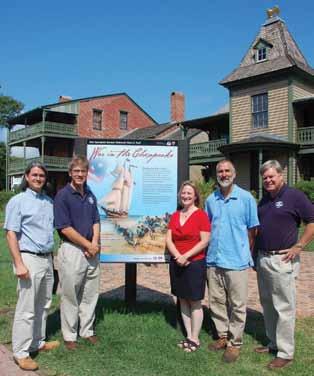
The Museum recently received a Maryland Heritage Areas Authority (MHAA) grant to support a Chesapeake Bay-focused War of 1812 exhibit. Coinciding with the 200th anniversary of the war’s Battle of St. Michaels, the exhibit is scheduled to open in spring 2013 and continue through February 2015.
The Museum’s exhibit will focus on the issues and events related to the regional hostilities on the Chesapeake Bay. The exhibit will highlight local stories including shipbuilding during the time of the war, and the Battle of St. Michaels, which occurred on August 10, 1813.
“Most war exhibits focus on military battles,” explains Director of the Center for Chesapeake Studies Robert Forloney. “Our exhibit will focus on the social history of the war—like the stories of shipbuilders, farmers, sailors, and the men and women who lived throughout the Chesapeake region during the time of the war.”
The Museum became eligible for the MHAA grant when the Town of St. Michaels was included in the Stories of the Chesapeake Heritage Area in July 2012.
continued from page 7
“My husband Tom and I fell in love with St. Michaels during an anniver sary weekend visit,” recalls Stevenson. “I enjoyed working at the children’s hospital, but when I saw the opening at the Museum, I knew it would be my dream job. What makes it so reward ing are the people—the staff and
“Thanks especially go to the Commissioners of St. Michaels,” said Chief Curator Pete Lesher.
“The Commissioners took the necessary steps in the Town’s comprehensive plan to allow the Museum and other non-profit and government entities to become eligible for this grant program.”
In collaboration with the Maryland State Archives, the Museum is undertaking origi nal research concerning impressment, slavery, and African American experi ences during and following the war. Using a social history approach and focusing on the daily lives and work of regional people impacted by the war, the exhibit will provide visitors with larger contexts for understanding Chesapeake history.
MHAA has awarded 63 matching grants totaling $2,713,480 to Maryland non-profits, local jurisdictions, and other heritage tourism organizations. These grants support heritage tourism
projects and activities that expand economic development and tourismrelated job creation through the state.
The Museum is also a Star-Spangled 200 Official Partner in the statewide bicentennial commemoration of the War of 1812 and a National Park Service (NPS) Chesapeake Bay Star-Spangled Banner National Historic Trail participant.
volunteers, our Board of Governors, our members, donors, and visitors— who see the impact we’re making in people’s lives. These are our constitu ents, and finding ways to develop and strengthen these relationships is what I love most about my job.” Recently introduced membership initiatives
include monthly Member Nights that feature a variety of fun and interesting programs, and member express entry and hospitality areas offering free bever ages and snacks at all Museum festivals. Contact the VPs at dcrosson@cbmm.org or rstevenson@cbmm.org.
7 FALL 2012 THE CHESAPEAKE LOG THE CHESAPEAKE LOG FALL 2012 8 currents
Director of the Center for Chesapeake Studies Robert Forloney, Chief Curator Pete Lesher, Stories of the Chesapeake Heritage Area Executive Director Deborah Divins Davis, St. Michaels Town Commission President Michael Vlahovich, and President Langley Shook stand next to the recently installed Star-Spangled Banner War of 1812 kiosk, now at the Museum’s entrance.
Vice President of Development David Crosson.
Vice President of Constituent Services René Stevenson.
ANTIQUE & CLASSIC BOAT FESTIVAL CHESAPEAKE FOLK FESTIVAL
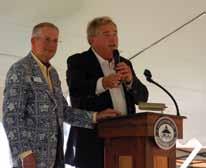
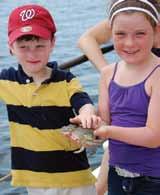
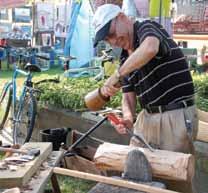
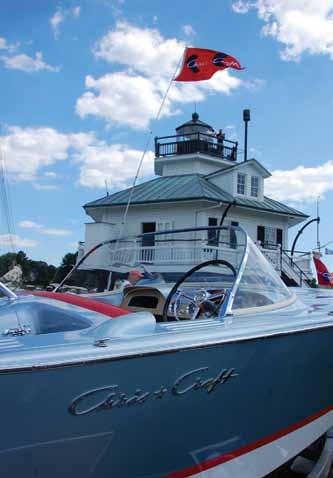
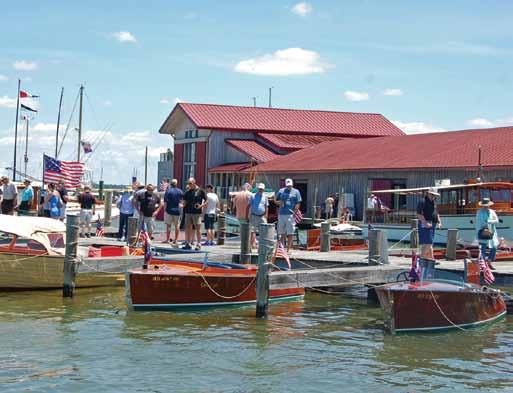
LOADING THE CANNONS UNDERWRITING PARTY
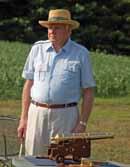
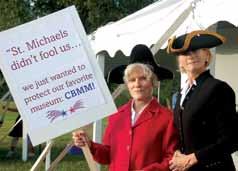
Friends of the Museum recently gathered at the home of Alexa and Tom Seip for a round of auctioning off everything but the kitchen sink for this year’s Boating Party. The party was graciously underwritten by Nancy and CG Appleby. (top row, left to right) Mariana and Pete Lesher, Alexa Seip, Boating Party co-chair Cindy Jurrius and son Scott. Jocelyn Eysymontt and Nancy Appleby. Joe Robillard, Mary Van Fossan, Usha Robillard, Boating Party co-chairs Geoff and Talli Oxnam, and Schuyler Benson. (bottom row, left to right) The crowd waits for the auction to begin. Bob Mantell prepares the cannon. René Stevenson, Rosa and Steve Sands, Langley Shook, Joe Peters, and Cindy Jurrius. Richard Kimberly and CG Appleby warm up the crowd.
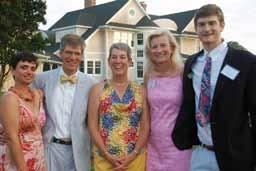
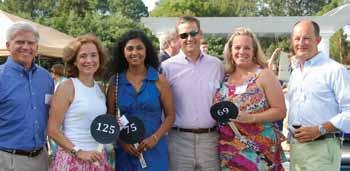
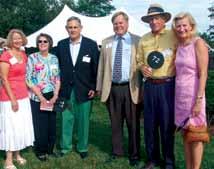
WATERMEN’S APPRECIATION DAY & CRAB FEAST
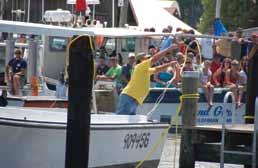

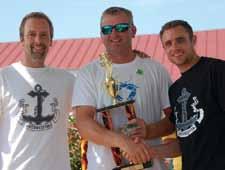
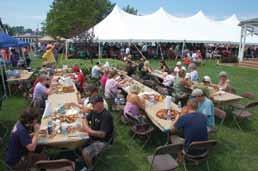
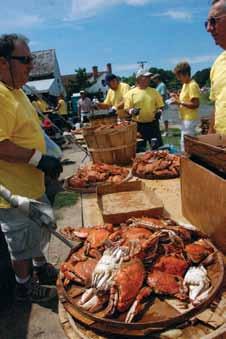

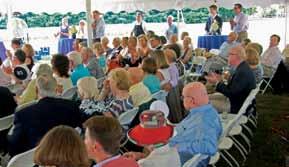
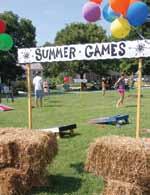
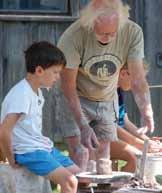
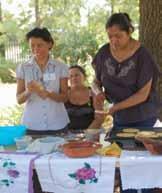

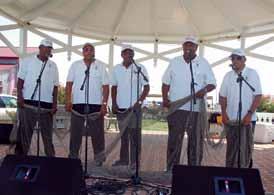
On Sunday, August 12, the 3rd annual Watermen’s Appreciation Day & Crab Feast welcomed 2,500 visitors to campus and featured Alaska fishermen and Reality TV stars Edgar Hansen and Jake Anderson of Discovery Channel’s “Deadliest Catch” (pictured top right). The event was hosted in partnership with the Talbot County Watermen’s Association and benefited both organizations. The day featured all-you-can-eat crabs, a boat docking contest, and silent auction. Hansen and Anderson met with festival-goers, signing autographs, and even tried their hands at a “Chesapeake Watermen’s Rodeo.”
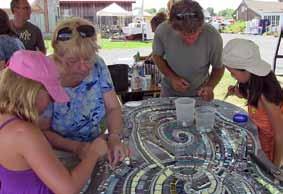
9 FALL 2012 THE CHESAPEAKE LOG THE CHESAPEAKE LOG FALL 2012 10 currents
The Antique & Classic Boat Festival, held annually on Father’s Day weekend, celebrated its 25th anniversary this year with nearly 5,000 visitors.
The Chesapeake Folk Festival, held on Saturday, July 28, welcomed 2,200 visitors to campus. This year’s festival “Treasures of the Bay...Hidden in Plain Sight” highlighted Chesapeake traditions from off the beaten path. Visit Chesapeakefolkfestival.org for more information.
The Flipside of a Tug Nameboard
by Elisabeth Meier
The nameboard for the tug Pocahontas is beautifully carved with rounded letters and carefully detailed scrollwork, raised high at the ends and emphasized by the shape of the edge of the board. Running your fingers over the intricate carving, P-O-C-A-H-O-N, the letters stop abruptly, with the right side just a sawn-off square. On the other side, the name Dover is flanked by its own scrollwork—a new nameboard carved on the back of an old one. The new board’s squared-off letters and thin, shallowly carved outlines indicate significantly less craftsmanship (and money) was invested in creating the recycled nameboard.

Although cutting down a well-crafted nameboard might seem thoughtless today, it was not an uncommon practice when nameboards were still an essential part of even the least decorated vessel’s ornamentation. Double-sided pieces like the Pocahontas/Dover nameboard provide some of the best examples of a ship’s history as it moved around and out of the Bay.
The tug Pocahontas was built in 1888 in Camden, New Jersey. This nameboard was likely carved then, and its careful craftsmanship displayed both the vessel’s name and the owners’ pride in their new tugboat. The Pocahontas first berth was in Norfolk, where she worked for the next 43 years. As was true for most tugs, the majority of the Pocahontas career in this period was unrecorded. But her time maneuvering ships from their berths into the busy maritime traffic of Hampton Roads was not uneventful. Pocahontas was involved in at least two collisions that
led to federal appeals court cases in 1919 and 1920. In 1931, the Pocahontas was sold to a new owner in Philadelphia and renamed Dover, thereby requiring new nameboards.
Perhaps unwilling to waste a perfectly good piece of wood, the new owners simply turned over the old Pocahontas nameboards and cut off what they did not need. The decision not to reshape the sawn-off end of the board and the shallow carving are equally indicative of the new owner’s thrift and utilitarianism.
Although the Dover, ex. Pocahontas, was scrapped in 1964, her nameboard survives due to the efforts of the collector Robert H. Burgess, who may have salvaged it himself as the tug waited to be broken up. Burgess did much of his collecting among abandoned vessels or those about to be destroyed, often rescuing pieces from scrap heaps, trash bins or rotting hulks in hopes of preserving the Bay’s vanish ing maritime connections. Burgess was particularly intrigued by tradi tional ship carvings—his collection contains more than fifty nameboards like the Pocahontas/Dover—as well as by the traditional art of ship carving. Inspired by his acquaintance with one
of the last figurehead carvers, William W. Geggie, a desire to preserve the nameboards in his collection, and an interest in re-creating ornaments he was unable to collect, Burgess became a proficient traditional woodcarver himself. At some point, Burgess laid out the missing end of the Pocahontas nameboard, evidently with the intention of restoring the board to its original appearance. Burgess never finished the work, however, so both the original nameboard and Burgess’s unfinished addition were a part of his collection when the Museum purchased it in 2006. The practice of carving nameboards has not died out, as Burgess feared it might, even though very few vessels on the Bay still carry them.
John Garlick of Easton, MD, continues the craft today. In July, during the second of two weeks spent at the Museum demonstrating and teaching carving classes, he was able to bring the Dover/Pocahontas name board, a part of the Museum’s historic collections, into living tradition. Using the pattern Burgess laid out, and with the original nameboard as a guide, Garlick carved out the missing “TAS,” just as the original was made 124 years ago.
Profile: John Ford
by Tracey Munson
Whether presiding over an Easton Town Council meet ing as a long-standing elected official, or working and volunteering as the Chesapeake Bay Maritime Museum’s staff liaison with the Mid-Atlantic Small Craft Festival’s (MASCF) steering committee, one thing remains the same—John Ford makes sure every voice is heard.
Now serving as Facilities Manager, Ford has been with the Museum and the festival since 1990. Along the way, he’s also served as Historic Cemeteries of Easton President, Easton Planning and Zoning Chair, Easton Town Council Ward 1 Representative, and Easton Town Council President.
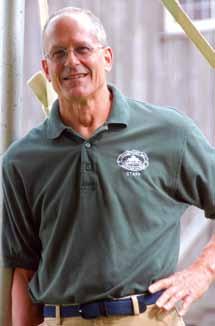
“John has a great ability to bring people together,” commented Chief Curator Pete Lesher and fellow Easton Town Councilman. “He’s mindful in making sure Festival participants’ ideas are heard—which is much the same style he employs with his constituents in Easton as well. John is a careful listener who builds a community of stakeholders in all of his endeavors.”
Ford was born in Iowa, and lived in Wisconsin before moving to Easton, MD, in 1966. He earned his BA in English from Towson University. Prior to working with the Museum, Ford kept close to the Chesapeake Bay through work at Crockett Brothers in Oxford and a marine construction company in Queenstown. Around that same time, Ford met Peggy Joseph of Havre de Grace at their respective best friends’ wedding. “We walked down the aisle together as part of the wedding party,” commented Ford. They later married in 1978, followed by the birth of their son Ben, on St. Patrick’s Day, 1983. “We were the first couple to be married in the Benedictine School’s chapel in Ridgely,” recalls Ford, noting Peggy was a teacher there at the time.
Ford also takes great pride in being one of the co-founders of CBMM’s Academy for Lifelong Learning and has served as secretary and Museum staff liason since its inception. Ford has taught numerous literature classes includ ing poetry, short stories, novels, and plays, and is conducting a course on Benjamin Franklin this fall.
When asked what the most gratifying aspect of his work at the Museum is, Ford notes his work with the Mid-Atlantic Small Craft Festival. “It may be the boats that bring people together here,” commented Ford, “but it’s the relationships, the ties of families coming together that make it so special The joy of working here is watching people enjoy this place.” More about this year’s MASCF on page 22.
Docent Education
Thursday, September 20, 10am
Exhibit Exploration: viewing and discussion of Muskrat Lovely film in Small Boat Shed.
Tuesday, October 9, 10am
Volunteer field trip to George Washington’s Mount Vernon to tour house and gardens: Volunteers to meet at Kent Island Park and Ride, near Kmart, to carpool. Each participant covers the cost of his/her own admission.
Tuesday, October 16, 10am
Exhibit Exploration: Pete Lesher and Kate Livie to lead workshop on interpreting the vessels and objects in the Small Boat Shed.
Thursday, October 25, 10am
Exhibit Exploration: Robert Forloney to lead workshop on object interpretation in the VLA.
Tuesday, November 6, 10am
Exhibit Exploration: Michelle Zacks to give lecture on African American Eastern Shore cultural connections in the VLA.
Tuesday, November 13, 10am Volunteer field trip to Chestertown: Kate Livie to lead walking tour of the historic downtown, followed by lunch and a special guest.
Volunteers play a critical role serving the Museum’s mission. Whether you donate time at the reception desk, building boats, or leading tours, the Museum appreciates and welcomes any amount of time you are able to offer. Contact Director of Events and Volunteer Programs, Melissa Spielman at mspielman@ cbmm.org or call 410-745-4956.
11 FALL 2012 THE CHESAPEAKE LOG THE CHESAPEAKE LOG FALL 2012 12 curator’s corner lifelines
The original trialboard (left), paired with a carving done recently by John Garlick.
Tide, Trade, and Tugs:
The Ward Family of Deltaville
by Michelle Zacks
Through four generations, the Ward family has navi gated the currents of the Chesapeake Bay. These days, the family operates one of the last “mom and pop” tugboat companies on the Bay. The youngest tug operator in the family, Jay Ward, captains the Capt. Johnny. This modelbow tug proudly bears the name of Jay’s great-grandfather, John T. Ward, the man who first plunged the family into the business of moving cargo from rural tributaries to urban ports on both sides of the Bay. John T. left his home in Crisfield at age 13, looking for “anything he could do to make a dollar,” as his grandson John M. Ward puts it.
In Baltimore, he found work hauling supplies out to ships for Vane Brothers, then a Fell’s Point ship chandlery and ship repair company. A few years later, young John returned to Crisfield. Having gotten a taste for the business of transporting goods from shore to ship, he bought a boat and struck out on his own, “hauling anything he could,” his grandson explains. The work of hauling produce, crabs, and oysters brought John T. to Deltaville, a horizontal hook of land on Virginia’s western shore. Lapped by the Rappahannock River to the north, the Piankatank River to the south and scalloped by small creeks throughout, Deltaville is a Chesapeake maritime haven through and through, home to generations of watermen and boatbuild ers. There young John met Iva Deagle, the woman who became his wife. The couple had three sons: Melvin, Floyd T., and Milton.
Known to everyone as Captain Johnny, John T. Ward crisscrossed the Bay on a series of buy boats. The first Deltaville-built vessel he owned was the Iva W. Standing in the yard of Floyd T. and Jean Ward’s home, you can see the point of land between two creeks where shipwright John Wright built the sixty-foot vessel for Captain Johnny in 1929. After the Iva W., close to 20 wooden boats entered the Ward family business, the vessels growing increasingly bigger and able to carry larger loads.
Whether it was shoveling oysters before heading off to school, or repairing the boat on a Saturday afternoon when you’d rather be getting ready for a date, when you were part of Captain Johnny’s household you had to work. From their early teen years on, the boys helped their father run
crabs in the summer and early fall from the western shore over to picking plants in Crisfield; watermelons from North Carolina to Baltimore; and tomatoes and potatoes from fields throughout the Eastern Shore. The Ward family hauled seed oysters from the James River up the Rappahannock River for planting, and wintertime was spent dredging for crabs.
As it did for families and businesses throughout the country, World War II spelled many changes for maritime industries in the Chesapeake. During the postwar decades, trucks increasingly were used in place of boats for hauling produce and seafood. In response, the Ward brothers began carving out a niche for themselves by hauling corn, soybeans, wheat, and barley from the western and eastern shores of the Bay for delivery to Baltimore. As the centuries-old production of grain in the Chesapeake grew increasingly consolidated, the Wards continually upgraded to larger vessels. By the 1960s, Floyd T. was captaining the Mary S. Lewis, a ninety-foot oyster dredge boat purchased from Bridgeport, Connecticut. At two hundred tons, Mary S. Lewis approached a practical limit for what a wooden vessel could haul. So in the 1970s the Wards made the leap to steel boats, starting with the John W., a Newport
News-built barge on which they installed a pilot house and two engines. A decade later they made their shift to tugs, heading down to New Orleans to purchase the Gram-Me, a sixty-foot, 1000 horsepower push boat. Since then, they have added three other tugs to their small fleet. From pick-up points in Tappahannock, Kilmarnock, Kinsale, Baltimore and Seaford, the Ward tugs haul grain to Perdue processing and export facilities in Seaford, Salisbury, and Norfolk. The switch to tugs and barges has allowed the Wards to maintain the ties of tide and trade that connect their family to the Bay’s history. Before joining the family business, John M. Ward’s son Jay went through the Newport News Apprenticeship School of Shipbuilding. He learned a great deal from the program, but his hands-on tug education really took off when he worked as a deckhand for his father. As Jay explains, his father taught him a lot about working on the water and about playing as a team. One thing he learned from his father, Jay says, is that when “the weather’s bad and it’s cold…nobody wants to be in those situations. Everybody’s got to be in there and you kind of make the best of it.” With Jay at the wheel of the Capt. Johnny, the Ward family shows every sign that it will keep moving with the changes in the fruit of fields and sea to keep their roots in the maritime world alive and well.
Museum Folklorist Michelle Zacks interviewed Ward family members in Deltaville and Jay Ward aboard the tug Capt. Johnny en route to Salisbury. Photos and quotations from those interviews are part of the Museum’s new exhibit, Push and Pull: Life on Chesapeake Bay Tugboats. The Ward family of tugboaters also will be featured in a Museum program on November 16th. See the Calendar of Events on page 24 for details.
What’s Fresh?
Seasonal Selections from Education
by Kate Livie
As the leaves fall, and the temperatures finally silence the summertime cricket symphony, some of our most welcome Museum visitors return: the waterfowl that winter over in Fogg’s Cove. Waterfowl certainly add to our gorgeous local fall scenery (and nothing is more Eastern Shore than the plaintive sound of a flying V overhead), but at the Museum, they mean a little more: waterfowl represent a traditional resource that Chesapeake residents have relied on for thousands of years.
Exploring Public Perceptions of Science with ALL
by Esty Collet
This fall, the Academy for Lifelong Learning (ALL) invites you to explore public perceptions of science with Greg Farley, Director of the Center for Leadership in Environmental Education at Chesapeake College. This course will explore the public perceptions of science, the politicization of scientific information, the use and misuse of scientific information in the public arena, and the public-health, land-use, ethical, and other consequences of ignoring science in the public arena. ALL will also explore some recent research that attempts to explain why people choose to accept, or deny, scientific findings, and what this may mean for our democracy.
The program will run six weeks, Monday evenings October 1, 8, 22, 29 and November 5, 12 from 5:30-7pm in the Van Lennep Auditorium. This fall ALL offers 20 other programs, lectures and field trips on subjects as varied as the Civil War, the Windsor Chair, Exploration of the Saltmarsh, the Articles of Confederation and the Constitution, the Legal Process, Ghost and Ghoulies, Benjamin Franklin, Belief, and more. For more information about these programs and to register, call ALL at 410-745-4941 or download an online catalog at cbmm.org/all.
This fall, in honor of our water fowling culture, as well as our gunning community, we will be offering several educational programs that focus on our relationship with the Bay’s winter birds. For beginner hunters, a hunter’s safety certification program is available in October to teach the fundamentals of gunning responsibly. In November, a special waterfowling workshop will teach hunting skills such as duck and goose calling, laying water and field spreads, retriever basics, as well as sessions on traditional decoys, vessels, and tools of gunners from the Chesapeake’s past. (See the calendar on page 24)
It’s exciting to find new oppor tunities to educate our members and our visitors about the different ways the Chesapeake’s people have explored and interacted with their environment. Especially, like waterfowling, when it’s a story as old as the Chesapeake itself.
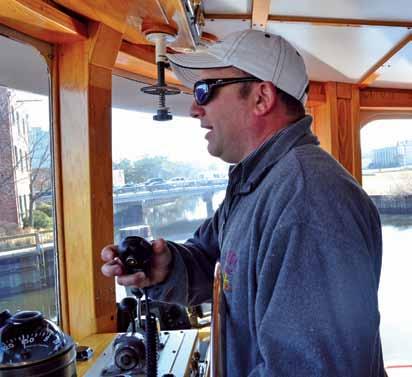
13 FALL 2012 THE CHESAPEAKE LOG THE CHESAPEAKE LOG FALL 2012 14
education
research
PHOTO BY JAMI LUBURGH WARD
Aboard the tug Capt. Johnny in Salisbury, Captain Jay Ward radios the bridge tender to request the raising of the Main Street bridge.
“Gentlemen… the Situation Has Changed.”
February 5, 1975, and made the initial offer. In a letter dated February 6, Brown thanked Holt for the visit.
“Just a note to let you know how much I enjoyed the conducted tour yesterday. I was amazed to see the extent of your facilities.” Brown went on to write, “I talked with Captain Parks yesterday, and he is willing to go along with your proposal to purchase the Rosie Parks for $25,000, with approximately 1/3 at the time of delivery, and the balance over a two year period.” Brown, obviously a good salesman with a sense of how to strengthen a connection, concluded the letter with the following post script: “Am enclosing my check and application for supporting membership.”
The letter appears to be more of a record keeper than breaking news because on the very same day, Holt began laying out his goal to buy Rosie to members of the Museum’s board.
“We have $6,500 in restricted funds for the purchase of a skipjack, which we need to round out our exhibits of available sail boats of the Bay,” Holt wrote to Museum board member S. Paul Johnston on February 6, 1975.
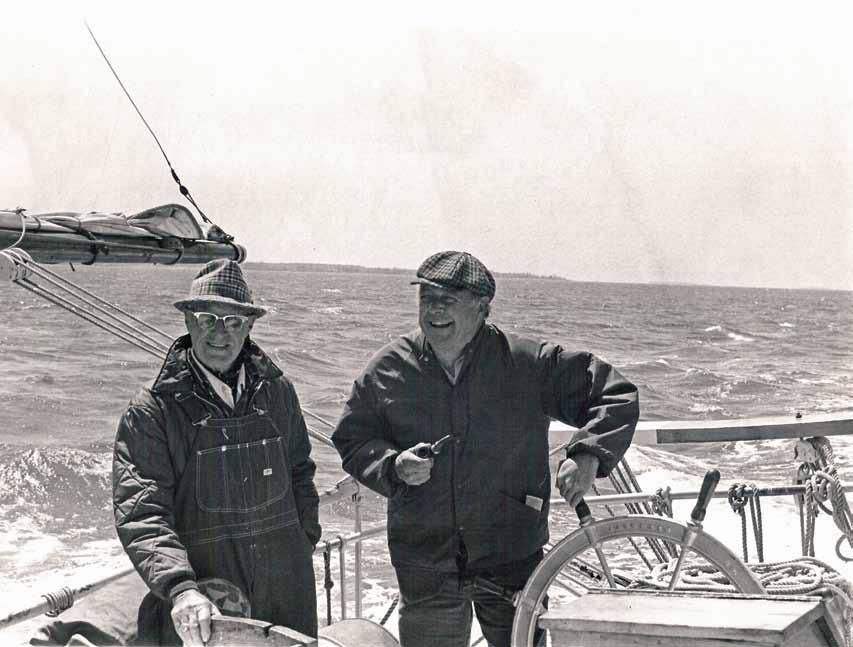
with Dacron sails and has been kept in yacht condition since she was launched. While Captain Parks is asking $30,000 for the Rosie, we could probably get her for $25,000. The public relations value of acquiring the Rosie Parks would be of great importance to the Museum.”
formal offer of $25,000 for the skipjack spelling out the terms, and included a $2,000 check as a show of good faith. The old captain signed the letter of agreement with a somewhat shaky hand.
In the early months of 1975, R.J. “Jim” Holt, the first full-time direc tor of the Chesapeake Bay Maritime Museum, quietly worked out a plan to expand the floating fleet by making a major acquisition. The Museum was entering its second decade, and if it was going to continue to make its mark on the region, it needed a skipjack—the iconic symbol of the Bay. According to letters and documents preserved by the Museum, everything started to come together for Holt that February and moved quickly. On April 26, Holt had his prize as he helped sail the skipjack Rosie Parks into St. Michaels harbor. Today, almost four decades later, the Rosie is being reborn as Master Shipwright Marc Barto and his
apprentices work to bring the famous vessel back to what she looked like when Bronza Parks built her in 1955.
By 1975, the Museum’s fleet had grown to 36 Chesapeake vessels, ranging from the historically significant logbuilt bugeye Edna E. Lockwood, down to sailing skiffs and a one-log dugout, most of which had been donated. Not all the boats were floating and many were in bad repair. It was a constant struggle to keep the 50-foot, roundbottomed sloop J.T. Leonard from sinking at the dock. The good skipjacks on the Bay were still a major part of the oyster fishery and were too valuable for their owners to even consider selling them to an upstart museum. Four years earlier, the Museum had established
a “Skipjack Fund” for the express purpose of buying a skipjack and Holt had looked at a few boats, including the Rebecca T. Ruark.
He then learned that the wellrespected oysterman Captain Orville Parks was in ill health and had come ashore for good. Parks’ skipjack, the Rosie Parks, was well known on the Bay, having won several honors in the Sandy Point and Deale Island windjammer races. Holt began working behind the scenes with Luke Brown, an Annapolis boat broker who had Rosie listed for sale at $30,000 (about $120,000 in today’s dollars.) Holt thought $25,000 would be a number he could raise if he had a year or two to work on it. He arranged for Brown to visit the Museum on
Johnston was an influential Museum supporter who lived in Bozman. He was a World War I biplane pilot; former Saturday Evening Post editor who had warned the world in 1939 about advancing German air power; a member of the agency that evolved into NASA; and had served as head of the Smithsonian’s National Air and Space Museum. Holt started out his letter by writing, “Along with the Master Plan, we should include plans on the floating exhibits.”
He went on, “It was brought to my attention that Captain Orville Parks, owner of the Rosie Parks, suffered a heart attack several weeks ago and the Rosie Parks is no longer dredging. She is now available for purchase. As you know, the Rosie Parks is the best known Skipkjack on the Bay and was built by B.M. Parks in 1955. She is equipped
Later in the letter, Holt writes “I have talked with Richardson’s Boat Yard and they advised me that the Rosie Parks is in better condition than any of the skipjacks on the Bay…. Captain Orville Parks has also been contacted and he is very interested in the Rosie Parks going to the Chesapeake Bay Maritime Museum. He will accept $25,000 paid over a 3 year period of time in thirds. He will not sell the boat until hearing definitely from us.”
On February 17, Holt met with the Executive Committee of the Board and received its unanimous support. He also put forward his idea that the money should not be raised from the general membership. He was looking for 19 individuals of means willing to kick in $1,000 or more for this one-time purchase. The next day, he crafted a letter to Captain Parks extending his
On February 28, J. Geer Wilcox of Oxford, chairman of the Museum’s Development Fund Committee sent a letter to the full Board of Governors with the salutation:
“Gentlemen: An opportunity to correct a deficiency in the Museum’s Floating Exhibit, i.e., the acquisition of a skipjack, has come unexpectedly to the Museum. Until now, no boat has been available and until now the proper facilities to berth and maintain a skipjack, although in the final phases of construction, had not been completed and, therefore, were unavailable. The situation has changed. Probably the best known and most desirable skipjack on the Bay is available.”
Wilcox went on to assure his fellow board members that “this is not a ‘double dip’ attempt. It is, however, an appeal to you to help us with this project by soliciting a contribution or contributions from others possibly in your sphere of influence and contact. Your participation will allow us to take advantage of an opportunity which undoubtedly will never be duplicated as an addition to the Museum’s collection of Bay oriented exhibits.”
In a P.S., Wilcox wrote, “Such donations are, of course, tax deduct ible.” Wilcox’s appeal worked, the full amount was raised and the purchase of Rosie Parks was concluded.
On April 24, Holt sent a letter to the Avon-Dixon Agency in Easton adding Rosie to the Museum’s insur ance policy. Veteran Eastern Shore journalist Anne Stinson joined the crew and dignitaries who boarded Rosie in Cambridge the morning of April 26, 1975, to chronicle its voyage to St. Michaels for The Star-Democrat Story continued on page 19.
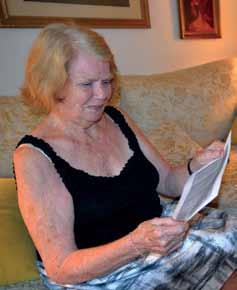
feature 15 FALL 2012 THE CHESAPEAKE LOG THE CHESAPEAKE LOG FALL 2012 16
Anne Stinson reading her 1975 Star-Democrat story on the Museum’s purchase of the Rosie
Captain Orville Parks and Museum Director R.J. “Jim” Holt aboard the Rosie Parks, en route to her new home at the Museum, 1975.
by Dick Cooper
PHOTO BY THOMAS H. SEWELL
History on the Half Shell
It was in Act Two of William Shakespeare’s The Merry Wives of Windsor that the world first encountered the phrase “Why then the world’s mine oyster/ which I with a sword shall open.” The timeless line of dialogue, originally meant as a threat in the play, has clung mollusk-like to our collective discourse since its original delivery on the weathered boards of the Globe Theatre in Elizabethan London. In the four centuries that have passed since it was penned, the phrase has transformed from salvo of aggression into a declaration of opportunity; today to proclaim that “the world is your oyster” is to see all life’s possibilities as pearls arrayed on the half-shell, yours for the plucking. It’s quite a fitting analogy, really, especially for people in the Chesapeake. Here in the Bay’s tidewater, oysters have represented precisely that prospect for as long as humans have been wrestling them open and sipping the essence of brine from their cupped shells. As a symbol of the opportunity for survival, for prosperity, for environmental harmony, and for innovation,
the humble oyster continues to be one of the Bay’s most significant, enduring and delicious connections between our past and our present.
To see evidence of the incredible breadth of the human relationship with the Eastern Oyster, Crassostrea virginica, all you need to do is head to the water’s edge. Throughout the watershed, especially in today’s lower, saltier reaches, you can discover evidence of generations of Chesapeake folk feasting on oysters. They’re called middens: ancient trash pits discarded by thousands of years of Indians reaping the Bay’s bounty and layered over millennia like the ultimate Smith Island cake. You can spot them crumbling where the waves lap ceaselessly at the shore, exposing piles of white, wafer-thin half dollars of shell dislodged with every high tide.
The edges of these ancient oyster leavings are smoothed with age and almost translucent—barely tangible reminders of the massive oyster reefs that would have emerged like marine cornucopia as the water receded twice each day. For the Indian communities
clustered near the waterline, oysters were a staple of their diet, as their middens attest. And these were no palm-sized dainties of the kind we relish today—rather, they were hulking ten-inch monsters, platter-scaled and needing to be cut into smaller portions for easy consumption. Due to the lack of an Algonquian written language, however, the earliest accounts of these gargantuan Chesapeake oysters come not from the Native Americans who had been reaping the rewards of oyster reefs for centuries, but from the diaries and letters of the early colonists. And what breathlessly enraptured, hungry descriptions they are:
“The abundance of oysters is incredible. There are whole banks of them so that the ships must avoid them,” said Francis Louis Michel in 1701. “They surpass those in England by far in size, indeed; they are four times as large. I often cut them in two, before I could put them into my mouth.”
Coming from a land where the populace had embraced oysters as a national fishery since the time of the
Romans, the English colonists consid ered oysters a familiar comfort food, a feeling clearly conveyed by their gleefully gustatory missives home.
In the wilderness of the New World, where much of the local plant lore was unknown and the average immigrant unskilled with a gun, oysters that could be dislodged by hand and eaten raw with gusto were a welcome and easy taste of home.
In the several hundred years following colonization, Chesapeake residents continued to rely on the oyster reefs adjoining their properties or communities for shellfish. Recipes from this era call for adding oysters and their liquor to a dish, cooking them until the oyster’s delicate sea taste had been transferred, and then spooning up the oysters and throwing them away. It was an embarrassment of riches—so monumentally-scaled and seemingly endless was the oyster population in size and scope that it was inconceivable to the 18th century Chesapeake person that humans could possibly make a dent. Oysters were so plentiful as to be disposable, so ubiquitous as to be invisible. Everyone ate them, regardless of social class, income or race.
Cooking wasn’t the only use for oysters, however; there was much to be made of
the stony carapace. Chesapeake towns used them to construct “corduroy roads” (alternating stripes of beam and shell) stretching miles in length through field, marsh, and forest. Oyster shells were infill, creating dry, buildable land where before had been protected coves, waving eelgrasses on the bottom.
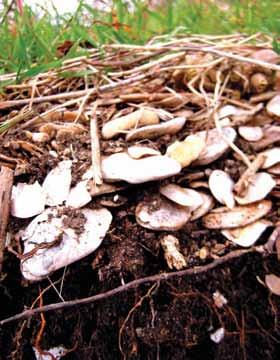
In other places, oysters’ role as the “foundation of the economy” had been a figure of speech. But in the Chesapeake, oysters literally supported transportation and construction on a large scale.
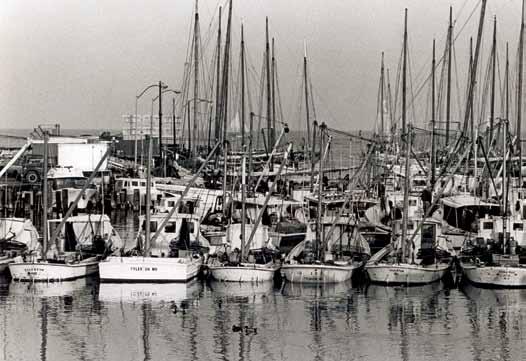
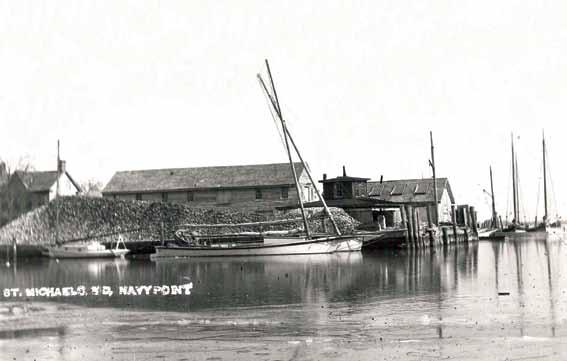
In towns like Crisfield and St. Michaels, and even the Chesapeake Bay Maritime Museum itself, whole portions of the community are held aloft by compacted shell, up to 20 feet deep. The centrality of oysters to Bay life only grew in the 19th century. Due to rapid technological advances of the Industrial Era, steam locomotion, canning and food preservation innovations, and the newfangled practice of dredging, the slow, local harvest of oysters transformed almost overnight into an international juggernaut.
Skipjacks sailed over the winter Bay, their decks piled high with the “white gold” from the bottom’s beds.
Chesapeake oysters, in brightly colored cans that boasted the unique flavor, origin, cleanliness, or freshness of their respective brands, were then packed and
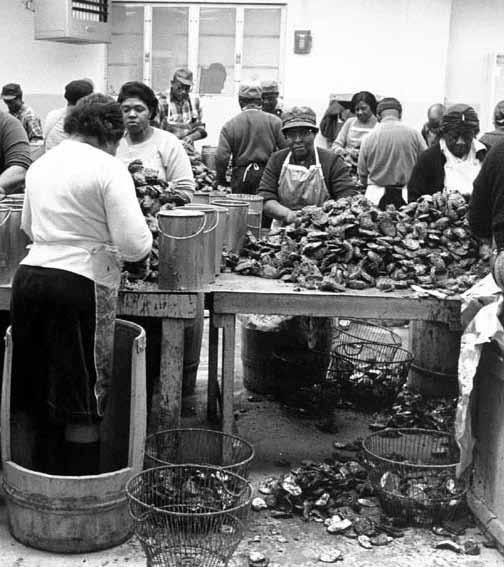
shipped far from the brackish waters of the Chesapeake. Gold rush miners, sod-busting pioneering communities and Chicago political fat cats alike dined voraciously on the delicate mollusks that had been a staple of the diet in the towns and cities they had left back East.
For a time, Chesapeake oysters fed the young, growing nation, and grow too did the coffers of the packing house industries back on the Bay shores. Hundreds of different packing houses, each with a different brand, explosively proliferated in working waterfront communities where oysters wetly fueled the economy. Towns like Crisfield sprang up virtually overnight on the shores of the Chesapeake, oriented toward their lifeblood, their engine, the fertile oyster reefs that crenellated the Bay’s bottom.
From the African-American women who shucked oysters in the unheated packing houses to the powerful railroad magnates who flooded their rail lines with boxcars laden with oyster cargo, many levels of society felt the impact of the oyster boom. But oysters, it seems, have a tipping point. Mature and ready for reproduction between one to three years of age, they need significant time to repopulate when harvesting or natural events, like freshwater surges,
17 FALL 2012 THE CHESAPEAKE LOG THE CHESAPEAKE LOG FALL 2012 18 Read more at Beautifulswimmers.tumblr.com
by Kate Livie
(From left) A close-up look at a midden, an ancient trash pit discarded by Indians. Discarded oyster shells piled high near the Caulk & McCready oyster house on Navy Point in St. Michaels, 1907. Skipjacks and patent tong oyster boats crowd into the Chesapeake Beach harbor, 1970. AfricanAmerican shuckers open oysters at the McNasby oyster house in Annapolis, 1969.
PHOTO BY THOMAS H. SEWELL
PHOTO BY ROBERT DE GAST
PHOTO BY ROBERT DE GAST
History on the Half Shell, continued from page 18. “Gentlemen... the Situation Has Changed,” continued from page 16.
eliminate adult oysters from the stock. For 50 years in the late 1800s to the turn of the century, there was no respite for the Bay’s oysters; the demand only grew. The peak of the oystering harvest was in the 1880s, when more than 20 million bushels of oysters were caught each year, and the myriad uses for oysters from flesh to spent shells were in such high demand the ancient oyster middens along the Bay’s shores were unearthed for use in fertilizer and chicken feed. But it wasn’t to last—that 20 million bushel catch would never again be attained. Slowly, year by year, the oyster catch, once believed to be in numbers beyond the reach of human impact, attenuated, and below the water line, the reefs, now relegated to strips of productive oyster beds, contracted correspondingly. By 1920, only four million oysters were harvested. Today, the harvest hovers at 100,000 to 150,000 bushels or less, and many of the oysters on the Bay’s bottom are threatened by diseases MSX and Dermo that, although harmless to humans, are devastating to the remaining oyster populations.
But oysters have always equaled opportunity in the Chesapeake, and as we approach a watershed moment in their harvest, they now represent the possibility for change, for dialogue, and for balance. Oysters, once valued only for their flavor, are now championed by conservation organizations as one of the Bay’s “founding fish”—creating habitat, kicking off the food chain, and most importantly, filtering the Chesapeake’s most formidable modern foe: algae. Watermen, too, tout oysters as one of the last prospects in the Bay for the traditional bounty of the Bay’s fishing economy, where a man with a boat, tongs, and a mission can make a living from an honest day’s work.
With the oyster population in jeopardy, watermen and environmentalists broadly agree that more Chesapeake oysters are a good thing, and vitally necessary for the environment and the economy. Figuring out the approach to ushering an oyster era back into the Bay, however, is much trickier and contentious. Do we end the oyster harvest all together? Grow the ones we eat artificially? Let companies take over the bottom and manage their own private plots? It’s a controversial issue, make no mistake, but it’s also one that goes right to the core of who we are and what we value, as Chesapeake residents. Over the next few years, there will be much disagreement and discourse, argument and innovation. But with a little luck, hard work, a lot of discussion and collaboration, and yes, the opportunity to guide the change, it’s not too late for the world of a healthy Crassostrea virginica population to again be our oyster. And that is one tasty prospect we all can agree on.
Like oysters? See page 23 for information on the Nov. 3 OysterFest.
Stinson says she has great memories of that day, and her old friend Captain Orville. “He was such a gentleman, a little on the formal side, but always warm and welcoming to me.” She says she had sailed on Rosie Parks before that day, reporting her first story about oystering. “I hadn’t done an oyster story yet and he said, ‘You can come with me Miss Stinson.’ ” In her 1975 newspaper account, Stinson wrote, “The Rosie Parks’ trip out of the Cambridge harbor Saturday morning with Captain Orville Parks at the wheel was an occasion of mixed emotions. It combined a pang of regret that one more skipjack was retiring from the oyster dredging fleet. More personally, it was a poignant time for the 79-year-old skipper, ordered by his doctor to leave a lifetime on the water.”
Stinson says she remembers Captain Parks talking about his late brother Bronza, who had been murdered by a mentally unstable customer 17 years earlier. “He talked about how much he missed his brother.”
After a cold, spray-soaked ride out of the Choptank and up Eastern Bay, Rosie rounded Tilghman Point and headed into the Miles River under full sail toward her new home at the Museum. “Captain Orville stood aside and Museum director Holt took the wheel for a turn as captain,” Stinson wrote. “Peter Black had a turn, followed by Ralph Wiley, Ted Graves and Hank Luykx. Their grins threatened to split their faces.”
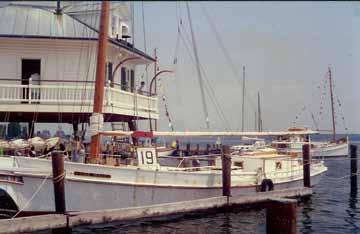

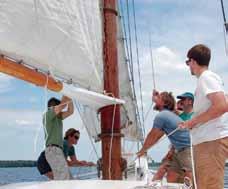

Thinking back to that day, Stinson, now 85, says, “One of the things that I recall was when we got to St. Michaels, Captain Orville clearly wanted to stay on the boat until the last possible minute. He was so reluctant to leave, he kept fussing over it. He wanted to make sure everything was clean and that everything was in its place. Then he got very quiet. He sort of collected himself and got off the boat. He walked away and did not look back.”
Edna sails again
by Richard Scofield
This July, the 1889 nine log bugeye Edna E. Lockwood returned to active sailing status after nearly a decade. In preparation over the past several years, the covering boards, which were yellow pine, were replaced with white oak. Log rails, monkey rails, and the patent stern were also replaced. Several deck beams, and a section of deck around the main mast partners were repaired. All of the running rigging was replaced and the stand ing rigging was served with tarred marlin. The iron ballast in her bilge was replaced with lead to prevent rusting.
Edna is the last original log hull bugeye still sailing in the world. She is a testament to the craftsmanship of her builder, John B. Harrison of Tilghman Island. With work continuing on the restoration of the skipjack Rosie Parks, the Museum hopes to have the two old girls racing against each other again in the near future. Edna’s restoration and maintenance are supported by a generous restricted donation by the Kimberly-Clark Foundation.
(top) Edna under full sail on the Miles River, for the first time in nearly a decade. (bottom left) The boatyard crew works to get the sails raised. (bottom right) Chief Curator Pete Lesher and Assistant Curator for Watercraft Richard Scofield at the helm.
Rosie Parks Update
As you see from the cover, the shipwrights have continued the process of caulking the deck, using traditional tools, cotton, and oakum. In addition, work has begun on Rosie’s bulwarks (the low walls built around the edge of the deck) and knees (used as natural angle brackets to fasten the deck to the hull, and reinforce critical structural locations).
(top) Captain Orville Parks’ granddaughters, Bonnie Ruest, Sharon Weber, and Janis Beach, and daughter-in-law Ruth Parks stopped by to check in on Rosie’s progress as Vessel Mantainance Manager Don MacLeod continues caulking.

(left) Boatyard volunteer Cliff Stretmater and Shipwright Apprentice Ken Philips work on the portside roller’s knees.

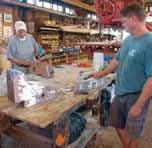
(middle) Philips works on Rosie’s bulwarks.
(right) Visitors from the Blind Industries and Services of Mary land take a tour of the Rosie Parks project and feel the grain of her wood with Director of CCS Robert Forloney.

on the rail 19 FALL 2012 THE CHESAPEAKE LOG THE CHESAPEAKE LOG FALL 2012 20
PHOTO BY DICK COOPER
Rosie docked along side the lighthouse, circa 1975.
d’Elegance set for September 30 sept/oct/nov
Woodcuts with Kevin Garber
Thursday, September 20 in the Boat Shop
6:30-8pm; $25 members; $35 non-members
Pre-register with Helen Van Fleet at 410-745-4941.
Meet master printmaker Kevin Garber as he demonstrates and discusses the proper techniques for duplicating a print from a Philip McMartin wood cut of the early 1960s. Garber’s works can be found in the Kemper Art Museum and Island Press at Washington University as well as in collections throughout the country, including the Whitney Art Museum in New York City.
Model Sailing Club Races
Sunday, September 23 at 11:30am, Fogg’s Cove
The Model Sailing Club builds and races a fleet of radio controlled skipjacks on weekends in Fogg’s Cove. During the winter months, models are built. The 48-inch skipjack models are built from scratch from plans sold by the club. The public is invited to join.
Lapstrake Skiff Workshop
September 28, 29 & 30 in the Bay History Building
Friday, 6-9pm, Saturday & Sunday, 9am-5pm $80 members, $95 non-members. All tools and materials are supplied. Pre-register with Helen Van Fleet at 410-745-4941 by Sept. 24 For more information, contact Model Guild Director Bob Mason at 410-745-3266.
Led step-by-step by skilled modelers, participants will create a 10-inch wooden rowing skiff with lapped side planking and a flat bottom. The 10-inch model is formed over a frame in much the same manner as a real boat is constructed. The Model Guild welcomes anyone 12 years of age or older and encourages new members of all skill levels.
CBMM’s Friday Open Boat Shop
Friday, September 28 from 5:30-8:30pm $20 members, $30 non-members. Pre-registration required. Participants must be 16 or older, unless accompanied by an adult. Pre-register with Helen Van Fleet at 410-745-4941.
Members of the public are invited to the boat shop to work on small projects of their own, or to bring ideas for a future project, and receive the advice of an experienced shipwright and woodworker. Participants can expect assistance with machinery and tools, plans, measurements, and the execution of a small-scale project, which could include a Christmas or birthday present, frames, furniture, models, artwork, etc.
6th St. Michaels Concours d’Elegance
Sunday, September 30. See sidebar.
30th Mid-Atlantic Small Craft Festival

Saturday & Sunday, October 6 & 7. See sidebar.
6th Annual St. Michaels Concours
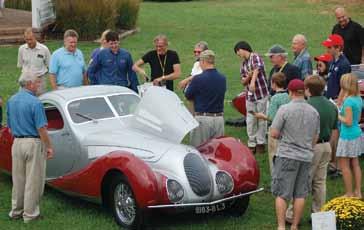
Mid-Atlantic Small Craft Festival XXX, October 6 & 7
sept/oct/nov
Girl Scout Woodworking Badge Day
Saturday, October 13, from1-4pm in CBMM Boat Shop $12 per participant. Register with the Girl Scouts of the Chesapeake Bay at 302-456-7182.
The Chesapeake Bay Maritime Museum will be holding a Girl Scout Badge Day in collaboration with the Girls Scouts of the Chesapeake Bay Council. Offered to cadettes, the requirements for a Woodworker badge will be fulfilled through fun hands-on activities, exciting tool demonstra tions and exploration of the real-life boats at the Museum, taught by Shipwright Jennifer Kuhn.
Intarsia Wood Plaque Workshop with Mary Sue Traynelis
Friday, October 12, 5:30-8pm in the Boat Shop
This 6th Annual St. Michaels Concours d’Elegance features coachbuilt automobiles, along with other significant, awardwinning motorcars from the Golden Age of Motoring (1900-1942), as well as a unique collection of automobiles from the post-war sports and racing era from 1948 through 1962. A collection of classic wooden speedboats from the same era will also be on display along the Museum’s docks.
The Concours kicks off with a participant welcome reception on Friday, September 28 at the Museum followed by a motor tour on Saturday, September 29. The round-trip motor tour begins at the Inn at Perry Cabin and travels to the Hyatt Regency Chesapeake Bay in Cambridge, before returning to St. Michaels.
On Saturday, September 29, a gala fundraiser at the Harbourtowne Golf Resort and Conference Center in St. Michaels is open to the general public and features cocktails, dinner, and a live auction. Tickets for the gala fundraiser are limited and available for purchase prior to the event.
On Sunday, September 30, the main event welcomes the public to the Museum with the display and judging of participating automobiles and an accompanying fashion show. Food and beverages will be provided by the Crab Claw Restaurant. Sponsors for the event include Jaguar Land Rover Annapolis, Porsche of Annapolis, Maryland Life magazine, and The Shore Life magazine.
General admission for Sunday’s event, which takes place from 10am to 4pm on September 30, is $30 for members and $35 for non-members, with all proceeds benefiting the children and adults served by the Museum’s educational, exhibit, and boat restoration programs. Tickets can be purchased in advance or at the Museum’s welcome center the day of the event. For more information, visit smcde.org or call 410-745-4978.
On Saturday, October 6, and Sunday, October 7, the Museum hosts one of the nation’s largest gatherings of small boat enthusiasts and unique watercraft at the 30th Annual Mid-Atlantic Small Craft Festival.
Museum visitors can marvel at the craftsmanship and innovation used in traditional and contemporary small watercraft while enjoying the Museum’s waterfront campus and hands-on exhibits, including the new tugboat exhibit and the historic restoration of the skipjack Rosie Parks.
Sailing skiffs, rowing shells, kayaks, canoes, paddle boats, prams, and one-of-a-kind boats will be on display and in the water throughout this family-oriented event. Boat owners hailing from all over the country will be available to share their knowledge and boating experiences with visitors.
Live music, scenic river cruises, food, and beverages will be available to round out the weekend festival. On Saturday, Museum boatyard staff and Chesapeake Wooden Boat Builders School instructors will be on hand to offer boatbuilding workshops and maritime demonstrations. Beginning at 1pm, a lively race of small craft out on the Miles River can be watched from the Museum’s waterfront and docks. Festival-goers can also vote for their favorite boat, with the People’s Choice award and others announced Saturday evening to participants.
On Sunday, festival-goers are invited to bring nauti cal items to swap or sell at a traditional swap meet. The Mid-Atlantic Small Craft Festival is free for Museum members and children under six, otherwise admission is $13 for adults, $10 for seniors, and $6 for children ages 6 to 17, with all museum exhibits open throughout the two-day festival. For more information, visit cbmm.org/mascf or call 410-745-2916.
Saturday, October 13, 10am-4pm (with break for lunch) $70 members, $85 non-members. Pre-registration required by October 3. Children 12 and up welcome with adult chaperone. Pre-register with Helen Van Fleet at 410-745-4941.
Intarsia is a woodworking technique that uses varied shapes, sizes, and species of wood fitted together to create a mosaic-like picture with an illusion of depth. Learn the basics for selecting different types of wood, cutting, sanding, and mounting to create your own intarsia wood plaque with Mary Sue Traynelis, who creates and sells intarsia and unique Woodsaics©, and Boatyard Program Manager Jenn Kuhn. Patterns for a lighthouse, owl, and sailboat will be available, with two sets of designs for each, ranging from beginner to advanced.
Hunter’s Safety Course
Wed.-Sat., October 17, 18, 19, 20
6-9pm, Wednesday-Friday in Van Lennep Auditorium Saturday, 9am-12noon at off-site location. $10 per person Students under 13 must be accompanied by adult Pre-register with Helen Van Fleet at 410-745-4941
To purchase a hunting license or to hunt in Maryland, state law requires you to successfully complete a Hunter’s Safety Course. This course includes instruction in hunter responsibility, firearms and ammunition, firearm handling and safety, marksmanship and shooting fundamentals, principles of wildlife management, bow hunting, muzzleloader hunting, tree stand safety, first aid, water safety, and Maryland legal requirements. Firearms are provided.
2nd Maritime Monster Mash
Friday, October 19, 5:30-8pm on Fogg’s Landing $10 members, $15 non-members, children 12 and under free
Chills, thrills and spooky family fun featuring dancing with DJ Chris Startt, costume prizes, ghost stories, haunted exhibits, refreshments, games for all ages, trick-or-treats for the kids, and a “Sea Nettle Nightmare” maze. Be on the lookout for Chessie, the legendary sea monster said to live in the Chesapeake Bay!
21 FALL 2012 THE CHESAPEAKE LOG THE CHESAPEAKE LOG FALL 2012 22 calendar
Model Sailing Club Races
Sunday, October 21 at 11am, Fogg’s Cove
See description on page 21.
Winterization with Paul Rybon
Thursday, October 25 from 6-7pm in the Boat Shop
$15 members, $25 non-members. Pre-register with Helen Van Fleet at 410-745-4941 by Oct. 16.
Museum volunteer Paul Rybon, a retired diesel mechanic with many years experience, teaches the basics on preparing your boat for the winter months. When registering, be sure to tell us the type of engine your boat has, so we can ensure your questions will be answered.
CBMM’s Friday Open Boat Shop
Friday, October 26 from 5:30-8:30pm
See description on page 21.
Half-Hull Model Workshop
Saturday & Sunday, October 27 & 28
9am-5pm in the Bay History Building. $80 for members, $95 for non-members. All tools and materials supplied. Pre-register with Helen Van Fleet at 410-745-4941 by Oct. 22.
For information, contact Model Guild Director Bob Mason at 410-745-3266 or email bobmason@atlanticbb.net.
Participants are invited to create a half-hull model of the Pride of Baltimore II. Band sawed from a block and carved to the rounded shape of the Pride’s hull, the half-hull model is then mounted on a baseboard to form a fine wall display piece.
OysterFest
Saturday, November 3. See sidebar.
Working Waterfront: Delaware
Thursday, November 1 at 6pm in Van Lennep Auditorium $8 for members, $10 for non-members
Pre-register with Helen Van Fleet at 410-745-4941
Delaware, celebrating her 100th anniversary, is a product of Bethel, Delaware’s great age of wooden boatbuilding at the beginning of the 19th century and one of the very last survivors. Join Vessel Maintenance Manager Michael Gorman, Boatyard staff and others with connections to Delaware’s long history as we take a close look at the recent conserva tion effort and share stories about a very special tug.
MEMBER NIGHT: Exhibit Spotlight:
Oystering on the Chesapeake
Wednesday, November 7 at 5:30pm. $5 members, $10 non-members. RSVP to Cheryl Miller at 410-745-4943. Join Director of Education Kate Livie as she explores the rich 400-year relationship between the Chesapeake’s people and its ‘founding shellfish’ through skipjacks, oyster cans, and dredges. Learn about the current controversies facing the traditional oyster fishery, and sample new ‘aquaculture’ oysters some small companies are growing as a sustainable new option.
is Saturday, November 3




From 10-4pm on Saturday, November 3, celebrate the Chesapeake’s oyster at the Museum’s OysterFest. The annual event features live music, oysters and other food, children’s activities, boat rides, oyster demonstrations, harvesting displays, retriever demonstrations, cooking demonstrations, and an oyster stew competition among regional chefs.
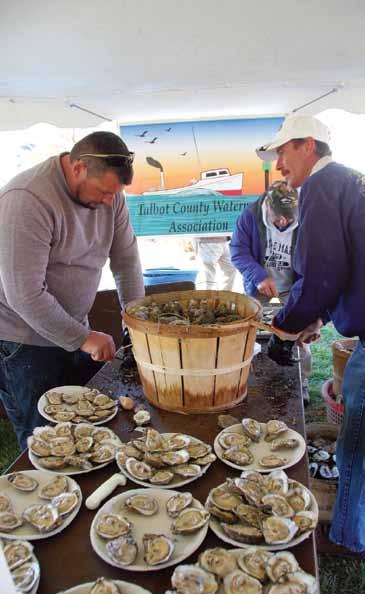
In addition to the Museum’s floating fleet of historic vessels, the Talbot County Watermen’s Association will have several boats dockside to help share the stories of how oyster dredging, hand tonging, patent tonging and diving for oysters have been longtime traditions of the Chesapeake Bay. The Talbot County Watermen’s Association will serve freshly caught Chesapeake Bay oysters on the half shell. In addition, hatchery-raised raw oysters and fried oyster sandwiches will be available. For those who prefer to celebrate oysters rather than eat them, pit beef, hot dogs and hamburgers, cold beer, caramel apples, warm apple cider, and more will be offered.
An oyster slurping contest among festival-goers and an oyster stew competition among regional chefs will offer bragging rights for the winners; with limited samples of oyster stew served along Fogg’s Landing beginning at 11am. Local restaurants will perform cooking demonstrations of their signature oyster dishes throughout the day. This year’s event features special cooking demonstrations by Culinary Ambassador of the Chesapeake Bay and on-air personality John Shields, who will be available for book signings.
OysterFest boasts plenty of family-friendly, educational, and fun activities designed to help kids get to know the oyster and how important the bivalve is to the Chesapeake Bay. You can explore an oyster nursery, learn how oysters clean the Bay by building your own filter, participate in a scavenger hunt or face painting, or watch dip-net making and knot-tying demonstrations. Build-a-boat activities provided by the Model Guild will be available for a $3 fee.
Dogs can even have fun, with retriever demonstrations taking place along the Museum’s waterfront, and don’t miss the scenic river cruises and on-the-water oyster tonging demonstrations with Chesapeake watermen. Conservation groups including Marylanders Grow Oysters, Chesapeake Bay Foundation, Oyster Restoration Project, and the Nature Conservancy will be on-hand to discuss efforts to clean and preserve the Bay. In addition, Philips Wharf Environmental Center’s Fishmobile will offer visitors the opportunity to see live sturgeon, diamondback terrapins, horseshoe crabs, and
other Bay creatures. The event is sponsored by Maryland Public Television, with its documentary Chesapeake by Air screened in the Van Lennep Auditorium during the event. The documentary captures the unparalleled wild beauty, history, and natural serenity of the Bay, all from above.
Festival-goers can explore the Museum’s exhibit buildings, including Oystering on the Chesapeake and Waterman’s Wharf, where visitors can try their hand at tonging or nippering for oysters. The Museum’s bugeye, Edna E. Lockwood, an 1889 log-bottomed oyster dredge boat and National Historic Landmark, will be on display.
Admission to OysterFest is $15 for adults, $12 for seniors, and $6 for children between the ages of six and 17. Children five years and under and Museum members are admitted free.
Food and boat rides are an additional cost. For more information, visit cbmm.org/oysterfest or call 410-745-2916.
CBMM’s Friday Open Boat Shop
Friday, November 9 & 23 from 5:30-8:30pm
See description on page 21.
Working Waterfront: Tide, Trade, and Tugs, The
Ward Family of Deltaville
Friday, November 16, 6pm in Van Lennep Auditorium $8 for members, $10 for non-members
Pre-register with Helen Van Fleet at 410-745-4941
The Ward family of Deltaville, Virginia, operates one of the last “mom and pop” tugboat companies on the Chesapeake Bay. Join us for an evening of conversation as several generations of the Ward family share stories of transporting crabs, oysters, produce, grain, and other goods by wooden buy boat, tug, and barge throughout the tributaries of the Bay.
Working Waterfront:
Women of the Maritime World
Thursday, November 29, 6pm in Van Lennep Auditorium $8 for members, $10 for non-members
Pre-register with Helen Van Fleet at 410-745-4941
Join us for an evening of discussion with some of the women who make the maritime world tick. Headed by Nancy Taylor Robson, author of Woman in the Wheelhouse, the talk will explore her experiences living and working onboard tugs as the wife of a tugboat captain and a licensed mate. The conversation will also include the voices of other salty females from all kinds of work, both educational and industrial, within the traditionally male field.
december
MEMBER NIGHT: Shop ’til You Drop!
Wednesday, December 5 at the Museum Store, 5:30pm
Find distinctive holiday gifts at our Musuem Store, specially stocked for the season. Members receive a 25% store discount and free gift wrapping, while enjoying wine and refreshments as they shop.
Fundamentals of Waterfowling Workshop
Friday, December 7 at 6pm, Bay History Building
Saturday, December 8 at 9:30am, Van Lennep Auditorium
Pre-register with Helen Van Fleet at 410-745-4941
Targeted toward beginner and intermediate hunters, this workshop offers the basics of gunning for Chesapeake waterfowl. On Friday, a workshop features a discussion and tour of the Museum’s decoys, firearms, and waterfowling vessel collections. Saturday’s program features hands-on demonstrations and classes, with participants working with masters of the sport to hone their calling techniques, rig layout and strategy, and retriever skills. The workshop will provde an up close and personal look at some of the world’s finest Chesapeake decoys, the tools and tales of the “Outlaw Gunner,” and conversation with experts in the gunning world. All participants must have Hunters Safety certification. Children over 12 are welcome to register with an adult chaperone. *Price to be determined, call for information.
23 FALL 2012 THE CHESAPEAKE LOG THE CHESAPEAKE LOG FALL 2012 24
calendar
We are extremely grateful to you, our donors, for your gifts to the Museum. Your support makes a huge impact on the lives of children and adults who visit the Museum and experience the Chesapeake Bay first hand through engaging educational programs, interactive exhibits like assisting our master shipwrights restore historic vessels, or taking an ecology cruise on our replica buyboat. Donors whose gifts were received between May 5 and August 17, 2012 are listed below. Thank you for helping us impact more lives with a deeper understanding and appreciation for the Bay. You truly are our heroes, and we couldn’t do it without you! THANK YOU!
The Chesapeake Bay Maritime Museum is recognized as a nonprofit organization under Section 501(c)(3) of the Internal Revenue Code. Gifts to CBMM are deductible to the full extent allowed by law. Please consider including CBMM in your trust or estate plans. Find out how you can leave a legacy of support for the Museum’s important mission by contacting René Stevenson at 410-745-4950.
Cheryl F. Albus
Elizabeth Anderson & Edward Delaney
Joy Anderson
Nancy & CG Appleby
John Bailey
Bryan Ball & Mark Palmer
Bank of America Foundation
Janis & Jay Beach
Ann & Bruce Bedford
Elaine & Ed Bednarz
Cathi & Franklin Berry
Kathleen & Brian Betz
Susan & Andrew Billipp
Ellen & Dick Bodorff
Mary Helen & Richard Bogan
Bonnie & John Booth
Booz Allen Hamilton, Inc.
Anne Marie & John Borneman
Rose Marie & Bill Bowles
Lydia & David Boyer
Cleo Braver & Allie Tyler
Victoria & Thomas Broadie
Jennifer & Paul Brooks
Adrienne & Dan Brouillette
Anna & John Burfeind
Burr Yacht Sales, Inc.
Rosalind & Paul Calvin
Donna Cantor & John Pinney
Kathy & Daniel Canzoniero
Danuta & Reno Carbonetta
CareFirst BlueCross BlueShield
Rick Carrion
Benjamin Clark
Joanne & George Clark
Classic Yacht Restoration Guild
Dara & John Clayton
Pru Clendenning & Robert Clopp
Sandra & Tommy Cobb
Carolyn & Phil Cohan
Jeri & Randy Collins
Shelley C. Collins
Debbie & Doug Collison
Gloria Lieberman & Laurence Conforti
Constellation Energy United Way
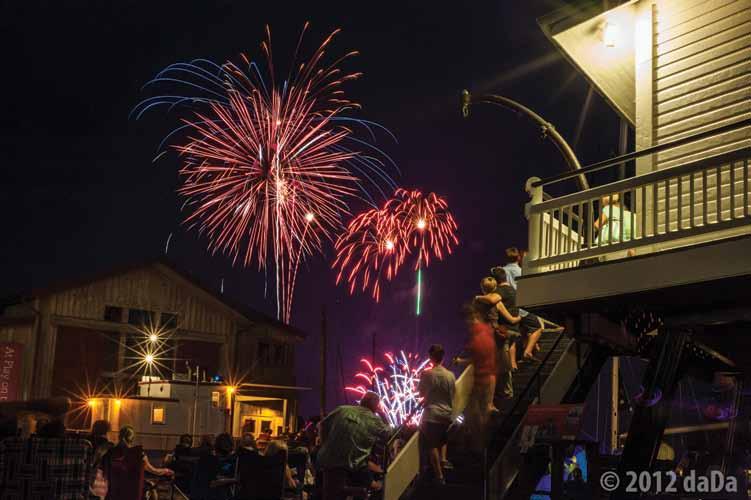
Megan & Landy Cook
Newbold Cooper
Pat & Dick Cooper
Pat Cornish
Alice & Lee Cory
Joan Cox
Crab Claw, Inc.
Noreen & David Craven
Robert Crowder
Kristine & Ralph Cruikshank
CSX Corporation
Judith & Robert Davis
Elizabeth Anderson & Edward Delaney
Michael Denworth
Martha D’Erasmo & Robert Rosenberg
John Devnew
Edith Donohue
Virginia Dorman
Alice Dorshow
Catherine & Pete Doyle
Evelyn & Bernie Doyle
Donna & Bill Dudley
Lynne & Buck Duncan
Fred Dunn
Susan duPont & Howard Snyder
East Coast Decoy Collectors
Leslie Steen & Robert Ebel
Charlotte & Gary Ehlig
Rona & Stuart Eisen
Peggy & Frank Emmet
Mae & Randy Ewell
ExxonMobil Foundation, Inc.
Jocelyn & George Eysymontt
Catherine Fagan & David Gantz
Rosemary & Joseph Fasolo
Anna & Chip Fichtner
Mary Kay & Tom Finan
Eric Flickinger
Ann Marie & Jim Flood
Elizabeth & Leo Foulds
Jeffrey Frank
Deborah & Paul Franke
Jaime & Gregory Frankos
Richard Franyo
Liz & Howard Freedlander
Patricia Freeman
Andy Friel
Christina & Earl Furman
Carol & Brice Gamber
Garden Club of the Eastern Shore
Judith & Bill Geoghegan
Gary Gerber
Doreen Getsinger
Michael Gilbert
Dagmar & Al Gipe
Victoria Gomez & Patrick Hartman
Michele & Robert Goodson
Marguerite & Bill Gray
Rosemary & John Gray
Pam & Tom Green
Penny & Alan Griffith
Guilford & Company
Guyette & Schmidt
Jennifer Habasahi
Mickey Haines
Kristen Hall
Patricia Hanlon & Bill Tylor
Susan & Paul Hanson
Harbourtowne Resort
Pam & Jim Harris
Joyce & Lawrence Harrod
Trish & Brooke Harwood
Chris Havener
Cecilia Hayes & Robert Klamm
Scott Hechand
Sylvia & Ralph Heidelbach
Jean Hemphill
Joan & Hunt Hendrickson
Kathleen C. Hendry
Ivonne Herrera
Roy Hess
Nancy Hickey
Andrea Hinkle
Elizabeth & Worth Hobbs
Susan & James Hobbs
Norma & Tom Hoff
Martie & Nelson Holtje
Juanita Hopkins
Jane & Frank Hopkinson
Marjorie & Richard Hottel
Betty T. Hurford
Jennie & Jack Hyatt
IBM Corporation Inn at Perry Cabin
Lesley & Fred Israel
Florence & Cliff Jackson
Pam & Jerry Jana
Sherry & David Jeffery
Ray Jennings
Curtis Johns
Johns Hopkins AP Services
Diane Johnson
Karen & Clark Johnson
Kerstin & Warren Johnson
Pearlie Johnson
Beverly & Richard Jones
Jane & Ian Jones
Cindy & Doug Jurrius
Joseph Kahn
Mary & William Kalis
Marilynn Katatsky & Rick Kaufmann
Peg Keller
Jill Kent & Mark Solomons
Joyce & James Kerridge
Susan & Stuart Kiehne
Karen & Dick Kimberly
Joan & Frank Kittredge
Merrilyn & John Knud-Hansen
Carleen & Frank Kulscar
Martha & Paul Ladenson
Barbara & Bill Lane
Deborah & Tom Lawrence
Shirley Leaf-Bealefeld
Doris Lee
Ron Lemieux
Annabel & Ron Lesher
Sara Imershein & Mark Levine
Pat & Ted Lewers
Simma & Ron Liebman
Christine Lojko
Germaine & Tom Louis
Matt Lynch
M & T Charitable Foundation
Kay & Joe MacDowell
Sherry & Charles Manning
Alice & Bob Mantell
Robin & John Marrah
Frank Marshall
Beverly & Stanley Martin
Bruce Martin
Billie Jane & Warren Marton
MD Dept of Bus & Econ Dev
MD Dept of Natural Resources
Carla & Albert Massoni
Eileen C. Mayer
Christopher McKee
Nancy & Fred Meendsen
Cathy & Tom Mendenhall
Josephine & George Merrill
Linda & Lawrence Meyer
Arna & Alan Mickelson
Barbara & Scott Millar
Maxine & Bill Millar
Alice & Dick Miller
Carolyn & Robert Miller
JoAnn & David Miller
Julia & Ken Miller
Priscilla Miller
Carolyn & Leonard Mizerek
Paul Moates & Connie Sadler
Model Sailing Club of CBMM
Elizabeth & Rick Morgan
Ilene & Frank Morgan
Julie Moriarty & Bob Hockaday
Karen & Philip Morrison
Dorothy Mowry
Ann & William Moyer
Jon Mullarky
Judy & Bill Munn
Nancy & Jeff Myers
Melva Nash
Abigail & Mark Nestlehutt
Gerald O’Brien
Donald Ofte
Ann & Don Olson
Kristen & Nels Olson
Christy & Hamish Osborne
Rita & Al Osgood
Christine & Andrew Parish
Cammy & Tony Passarella
Leigh & Jerry Peek
Kay & Bob Perkins
Mary Lou & Joe Peters
Edna & Jerry Pettit
Betsy & Chuck Petty
Melissa & John Pflieger
Michele & Chip Pickett
Ginger & Buddy Pickle
Ellen & Norman Plummer
Ed Portner
Joanne & Paul Prager
Patricia & Milton Quick
Bruce Ragsdale & Rick Scobey
May & Peter Ramsey
William Rankin
Carol Raulston
Martha Read
Norma Redelé
Takisha Reece
Elisabeth & Mitchell Reiss
Eleanor Requard
Carol & Mike Richards
Claire Richardson
Frederick W. Richmond Fdn
Ride Entertainment Systems
Kari & Trey Rider
Jane & Jack Ritchie
Robb & Elizabeth Tyler Foundation
Roselee & Art Roberts
Usha & Joseph Robillard
Martha Roe
Barbara & William Rose
Eileen & Richard Rosenthal
Helena & Robert Savage
Julia Schen
Susan & Philip Schnering
Catherine & Charles Schutt
Elizabeth & John Seidel
Alexa & Tom Seip
Robert Seurkamp
Bernadette Benik & Dennis Seymour
Barbara & Michael Sheridan
Karen & Langley Shook
Dorothy Shortall
Liz & Sal Simoncini
Nancy & Edward Sipe
Barbara & Michael Smilow
Catharine & Richard Snowdon
Linda & Hank Spire
Elizabeth Spurry
Diane & Jeff Staley
Judy & Henry Stansbury
Cindy & Edward Stegemann
Joseph Stella
Jeanne & James Stephens
Barry Sterling
René & Tom Stevenson
Glenna Stewart
Sally & Roger Stobbart
Stephanie Stockman & Frank Ireton
Susan & Jack Stoltz
Kathy & Phillip Stovall
Chris & Steve Swift
Stephanie Swope
Talbot County Arts Council, Inc
Melissa Taylor
Suzanne & Robert Taylor
Ellen & John Thoman
Catherine & Stuart Thomspon
Debbie & Randy Thompson
Frankie Thorington
Ann & Peter Thornton
Muriel & Enos Throop
Ben Tilghman
Beverly & Richard Tilghman
Pat Tokarz
Margaret Tomlinson
Julie & Scott Tompkins
Debbie & Lawrence Turner
Stephen Twigg
Mary & Judd Van Dervort
Mary & Bobby Van Fossan
Allyn & Barry Van Vechten
Michael Vataloro
Barbara Viniar
Jane & Greg Virgil
Debra & Gregory Volack
Virginia & William Voorhees
Sara & Myron Walker
Rebekah & Ben Walrath
Alex & Andrew Walworth
Suzanne & Dennert Ware
Maggie & John Warfield
Missy & Seth Warfield
William Watts
Mary Ellen & Steve Weber
Marysue & Leon Wechsler
Judith & David Weiner
Dennis Weisberg
Charlotte & Arnold Weisshaar
Joan & Clif West
David Whitworth
Robert Widder
Joanne & Reed Wills
Wilmington Trust
David Wilson
Mary & Robert Wilson
Vickie & Bill Winterer
Ann & Barry Wood
Barbara & Lane Wroth
Wye Financial & Trust
Lisa & Tim Wyman
25 FALL 2012 THE CHESAPEAKE LOG THE CHESAPEAKE LOG FALL 2012 26
Heroes Honor Roll
Fireworks over the Hooper Strait Lighthouse during this year’s Big Band Night. Photo by Graham Scott-Taylor.
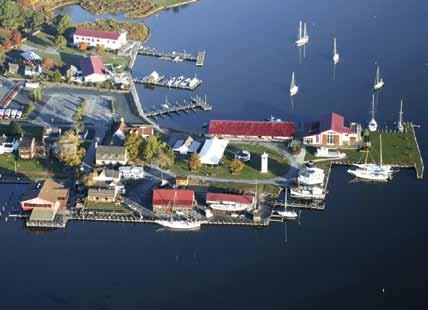

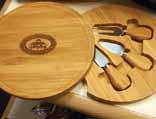



Chesapeake Bay Maritime
P.O. Box 636 St. Michaels, MD 21663 cbmm.org • 410-745-2916 Non-Profit Org. US Postage PAID Chesapeake Bay Maritime Museum ALOFT AERIAL PHOTOGRAPHY Members! Dock with Us OCTOBER SPECIAL: WEEKDAY DOCKING $1 PER FOOT (Sunday through Thursday, excluding holidays) INVITE A FRIEND: First-time members are eligible to receive $1 per foot docking discount. Just mention the “October Special” when reserving your slip. Open every day, the Museum offers 30+ slips, electric, pump-out, showers, and other amenities. RESERVATIONS REQUIRED For details call 410-745-4946, reach us on VHF16 or email dockmaster@cbmm.org. You’ll find a great selection of specialized Museum merchandise featuring the 1879 Hooper Strait Lighthouse, the legendary skipjack Rosie Parks, and more—including handcrafted jewelry, ornaments, clothing, ceramics, model boat kits, and regional books. 30% off and MOre On SelecT MercHandiSe wHile SupplieS laST cannot be combined with any other discount 410-745-4962 • cbmm.org/myshopify.com
Museum


































































